-
A net-zero steel sector and a coal phase-out in steelmaking by the early 2040s are technically feasible. This can turn iron and steel from a hard-to-abate to a fast-to-abate sector and be a key element to increase global climate ambition.
The key strategies to achieve such an accelerated steel transformation are material efficiency, an increase of scrap- and hydrogen-based steelmaking plus bioenergy and carbon capture and storage (BECCS).
-
Green iron trade can lower the costs of the global steel transformation and can be a win–win solution for green iron exporters and importers.
Transporting embodied hydrogen (H₂) as green iron will be significantly cheaper than transporting H₂ and its derivatives by ship. For countries with high renewable H₂ costs, green iron imports can increase the competitiveness of low-carbon steelmaking, thereby helping to safeguard local jobs in the steel industry. For green iron exporters, this can create new jobs and value added.
-
Carbon capture and storage (CCS) on the coal-based blast furnace-basic oxygen furnace route (BF-BOF) will not play an important role in the global steel transformation.
CCS on the BF-BOF route is unlikely to reduce direct CO₂ emissions beyond 73% and cannot address upstream emissions (coal mine methane leakage). Compared to other key technologies, steelmakers’ efforts to commercialise this technology are currently very low. If BF-BOF CCS does not materialise, new coal-based steel plants face a high carbon lock-in and stranded asset risk.
-
To unlock the full acceleration potential of the steel transformation, national governments need to create an adequate regulatory framework and develop cross-country strategic partnerships.
International cooperation will be needed to address key bottlenecks (i.e. DRI plant engineering, suitable iron ore qualities, low-carbon H₂), minimise stranded assets and help to unlock green iron trade.
- Format
- Impulse
- Date
- 15 June 2023
15 insights on the global steel transformation
This study summarises the key findings of our work on the global steel sector.

Preface
“We are walking when we should be sprinting.” With these words the Intergovernmental Panel on Climate Change (IPCC) Chair Hoesung Lee summed up the latest IPCC Synthesis Report. This IPCC report estimates that with currently implemented policies, the world is projected to warm by 3.2°C by 2100. Much greater efforts are needed to drive down greenhouse gas emissions faster.
The steel sector can play a key role in this. Often labeled as a hard-to-abate sector, the steel sector has the potential to turn into a fast-to-abate sector: our study demonstrates that a net-zero iron and steel sector by the early 2040s is technically feasible.
New key elements for an accelerated, lower-cost steel transformation include a swift roll-out of direct reduced iron technology, the creation of an international green iron trade, the phase-out of coal in steelmaking, and, above all, expanded international cooperation in tandem with targeted regulatory frameworks.
This study summarises the key findings of our work on the global steel sector. In future publications, we will provide more detailed analyses of low-carbon technologies, our 2050 decarbonisation pathways, the role of international green iron trade and the steel sector’s potential to generate negative emissions.
Key findings
Bibliographical data
- Authors
- Wido K. Witecka, Oliver von Eitzen Toni, Julian Somers, Dr. Kathy Reimann (all Agora Industry); Ole Zelt, Alexander Jülich, Clemens Schneider, Prof. Dr. Stefan Lechtenböhmer (all Wuppertal Institute)
- Publication number
- 298/03-I-2023/EN
- Version number
- 1.1
- Publication date
-
15 June 2023
- Pages
- 60
- Suggested citation
- Agora Industry and Wuppertal Institute (2023): 15 insights on the global steel transformation
- Project
- This publication was produced within the framework of the project Global Steel Transformation.
Downloads
-
Impulse
pdf 5 MB
15 Insights on the Global Steel Transformation
This study summarises the key findings of our work on the global steel sector.
-
議論への一石
pdf 6 MB
世界の鉄鋼産業の 脱炭素化に関する 15の知見
Impulse in Japanese
-
Impulse
pdf 5 MB
15 Wawasan tentang Transformasi Industri Baja Global
Impulse in Indonesian
All figures in this publication
Pathways to net-zero: annual CO₂ emissions in the steel sector (left) and key metrics (right)
Figure 1 from 15 insights on the global steel transformation on page 8

Under consideration of the Creative Commons license CC BY (attribution) the image may be further processed in any format or medium (also commercially, also in modified form), as long as the author is mentioned and a link to the license is given.
From hard-to-abate to fast-to-abate: how the steel sector’s role is changing
Figure 2 from 15 insights on the global steel transformation on page 9
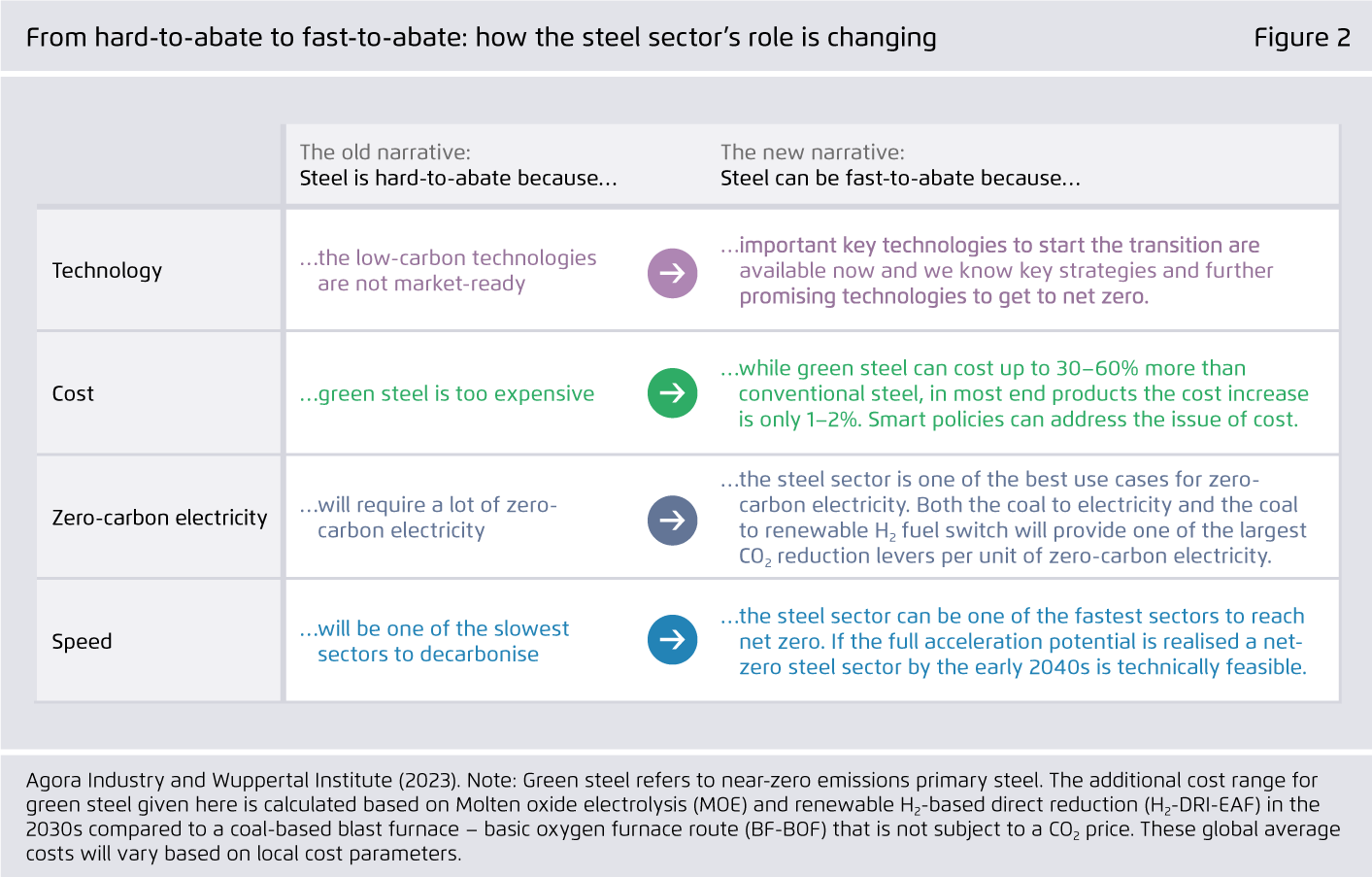
Under consideration of the Creative Commons license CC BY (attribution) the image may be further processed in any format or medium (also commercially, also in modified form), as long as the author is mentioned and a link to the license is given.
Scenario comparison: Global CO₂ emissions (left) and iron and steel sector emissions (right)
Figure 3 from 15 insights on the global steel transformation on page 11
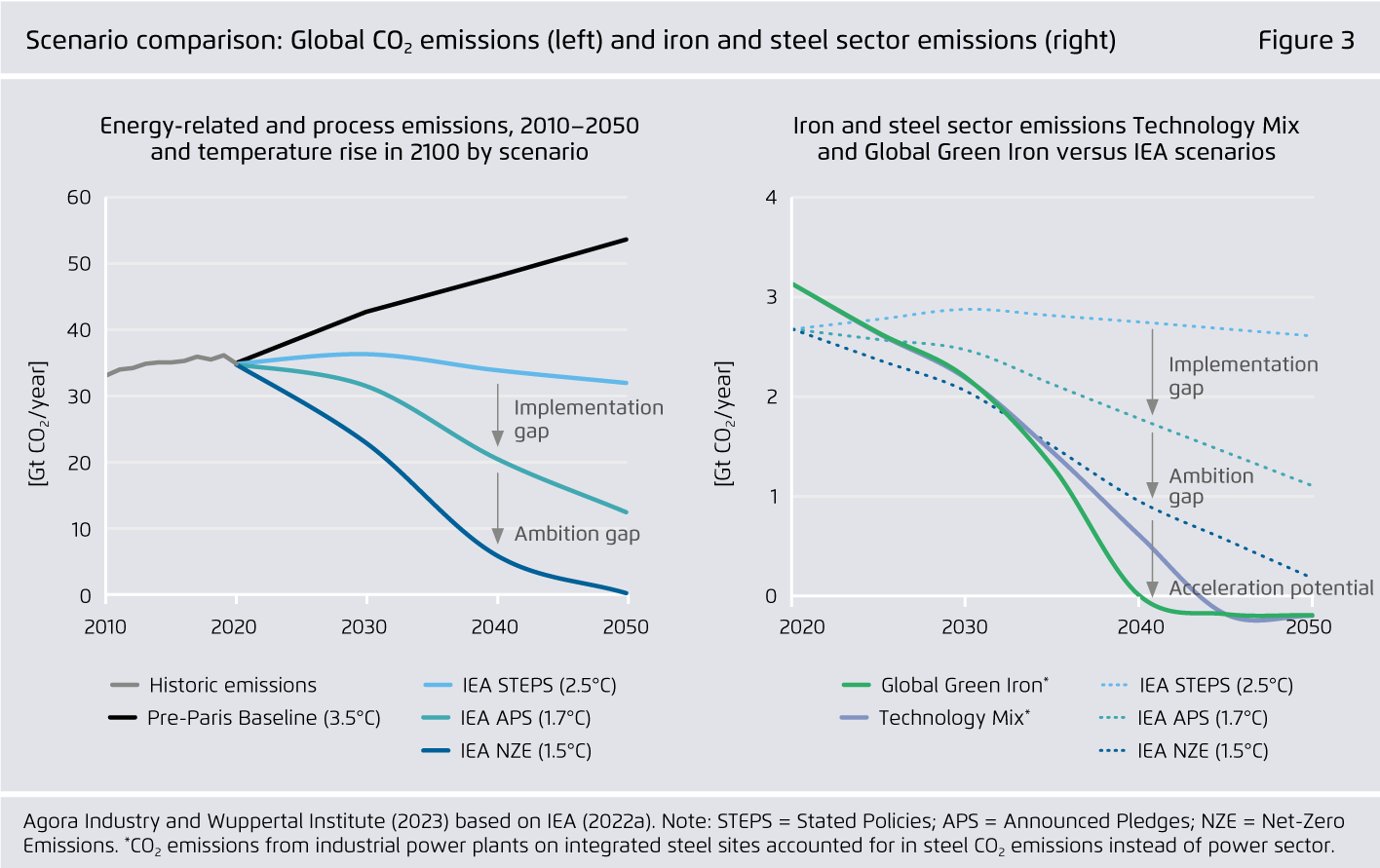
Under consideration of the Creative Commons license CC BY (attribution) the image may be further processed in any format or medium (also commercially, also in modified form), as long as the author is mentioned and a link to the license is given.
Scenario comparison: Iron and steel sector CO₂ emissions per year (left) and cumulative iron and steel sector CO₂ emissions (right)
Figure 4 from 15 insights on the global steel transformation on page 13
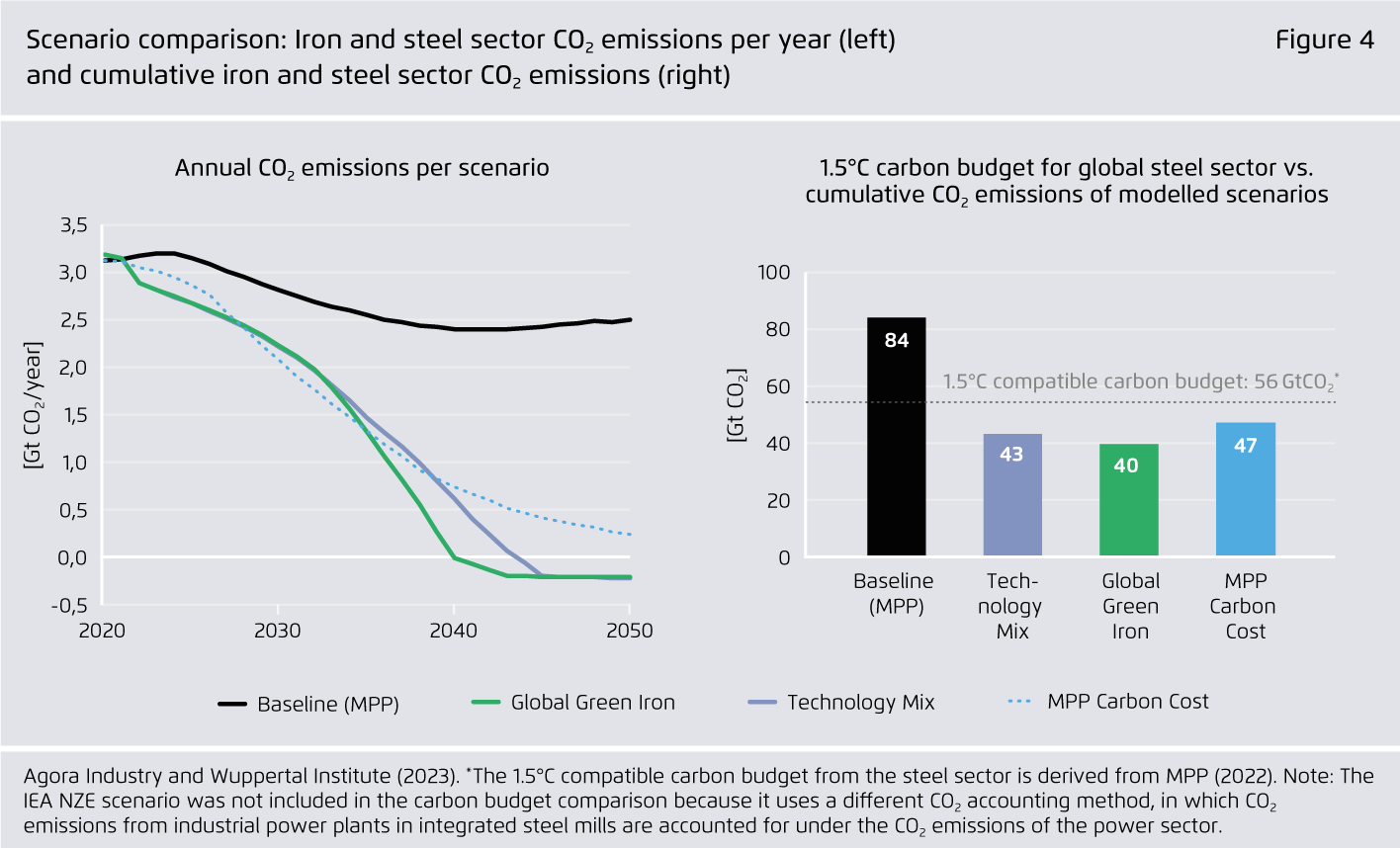
Under consideration of the Creative Commons license CC BY (attribution) the image may be further processed in any format or medium (also commercially, also in modified form), as long as the author is mentioned and a link to the license is given.
Scenario comparison: steel production per route (2020–2050)
Figure 5 from 15 insights on the global steel transformation on page 14
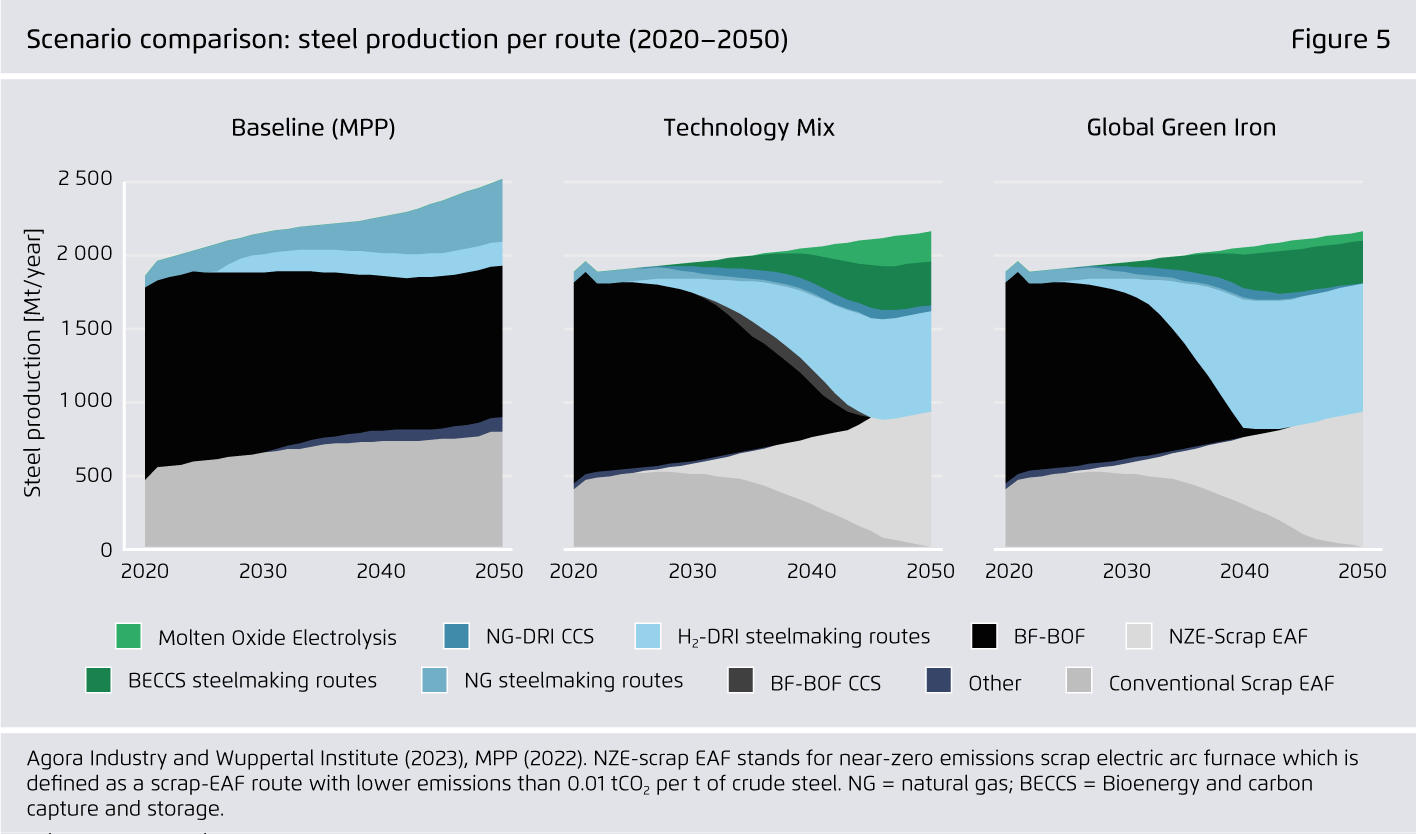
Under consideration of the Creative Commons license CC BY (attribution) the image may be further processed in any format or medium (also commercially, also in modified form), as long as the author is mentioned and a link to the license is given.
Scenario comparison of 1.5°C compatible steel decarbonisation scenarios
Figure 6 from 15 insights on the global steel transformation on page 16

Under consideration of the Creative Commons license CC BY (attribution) the image may be further processed in any format or medium (also commercially, also in modified form), as long as the author is mentioned and a link to the license is given.
Scenario comparison: Final energy demand
Figure 7 from 15 insights on the global steel transformation on page 18
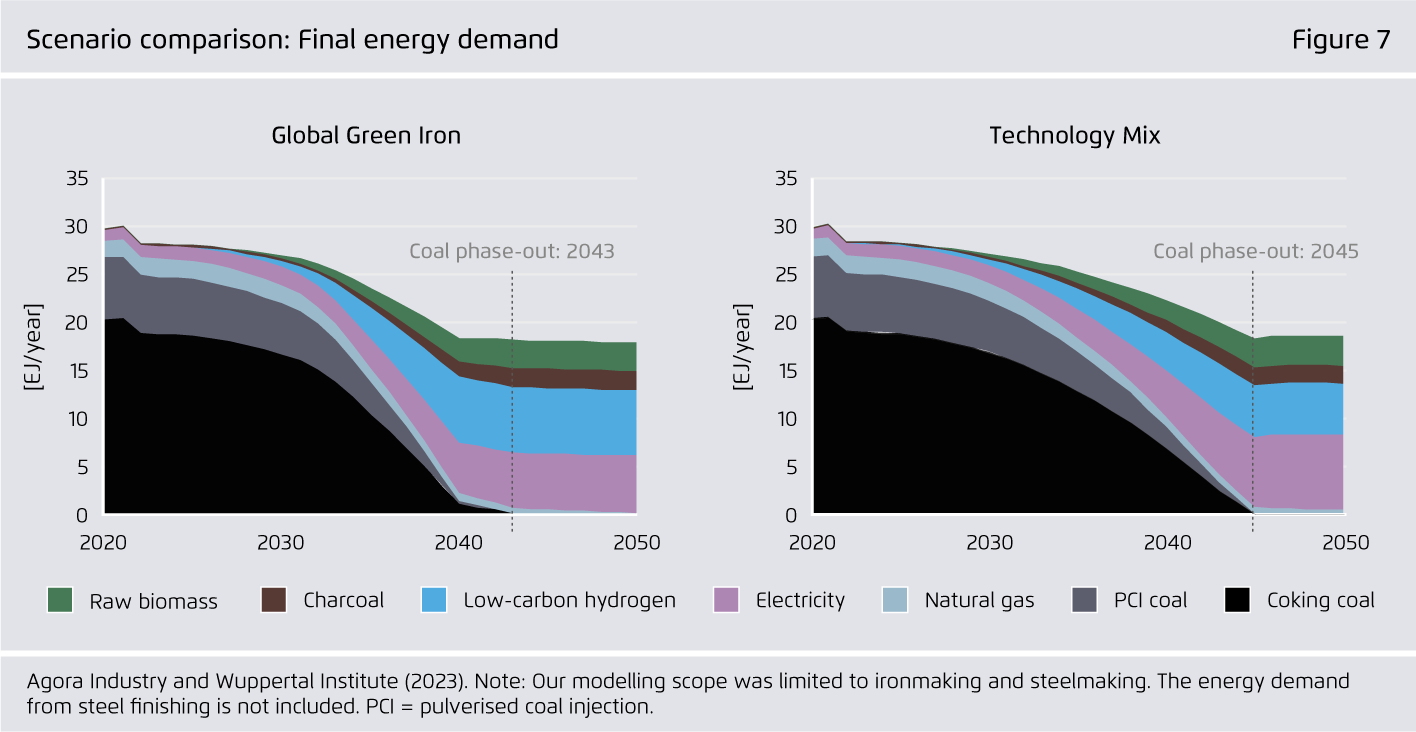
Under consideration of the Creative Commons license CC BY (attribution) the image may be further processed in any format or medium (also commercially, also in modified form), as long as the author is mentioned and a link to the license is given.
Residual CO₂ emissions (scope 1 and 3) of breakthrough technologies and proposed IEA near-zero emission threshold for primary steel
Figure 8 from 15 insights on the global steel transformation on page 19
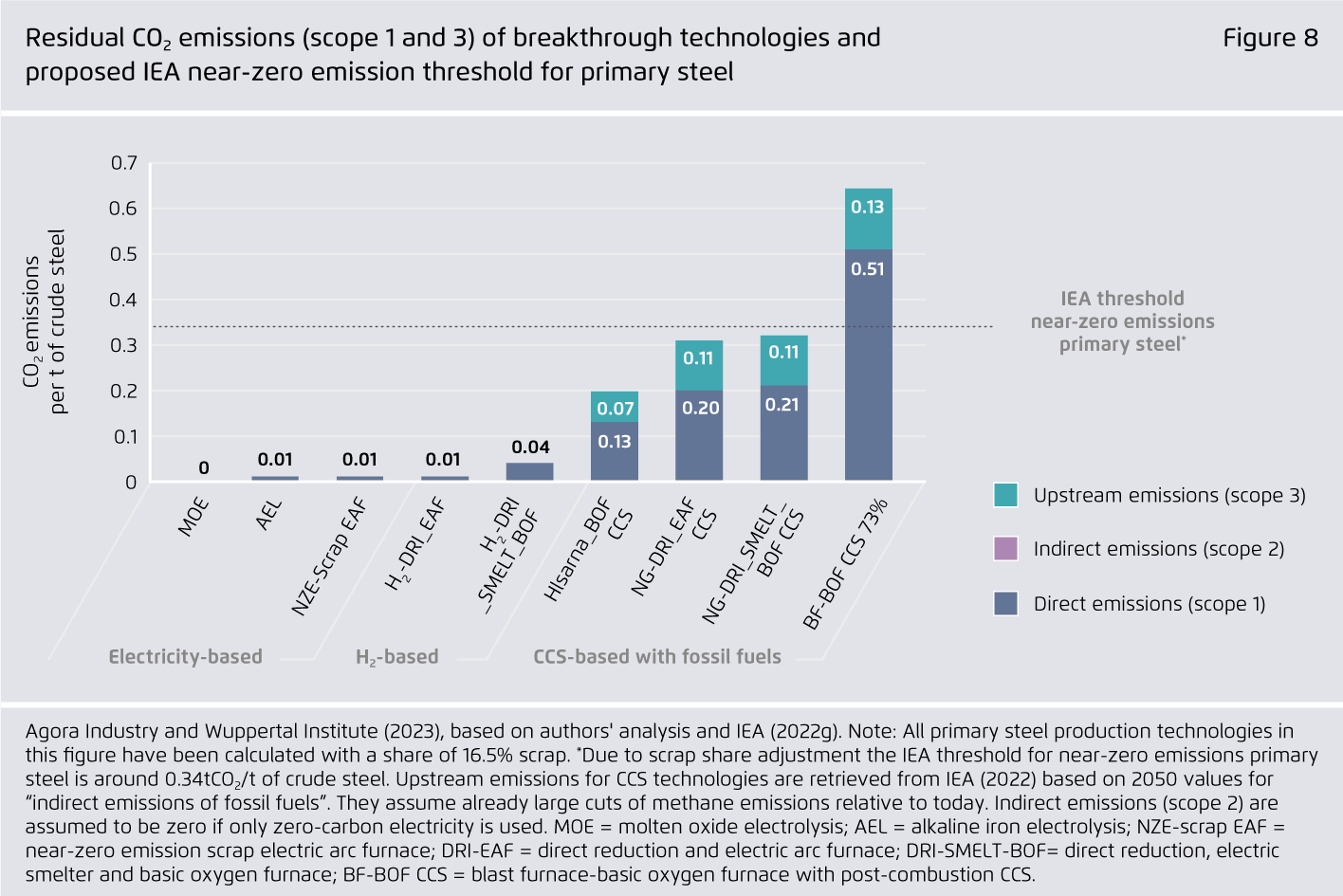
Under consideration of the Creative Commons license CC BY (attribution) the image may be further processed in any format or medium (also commercially, also in modified form), as long as the author is mentioned and a link to the license is given.
Impact of renewable H₂ input cost on green iron production cost 2030 under various scenarios
Figure 9 from 15 insights on the global steel transformation on page 21
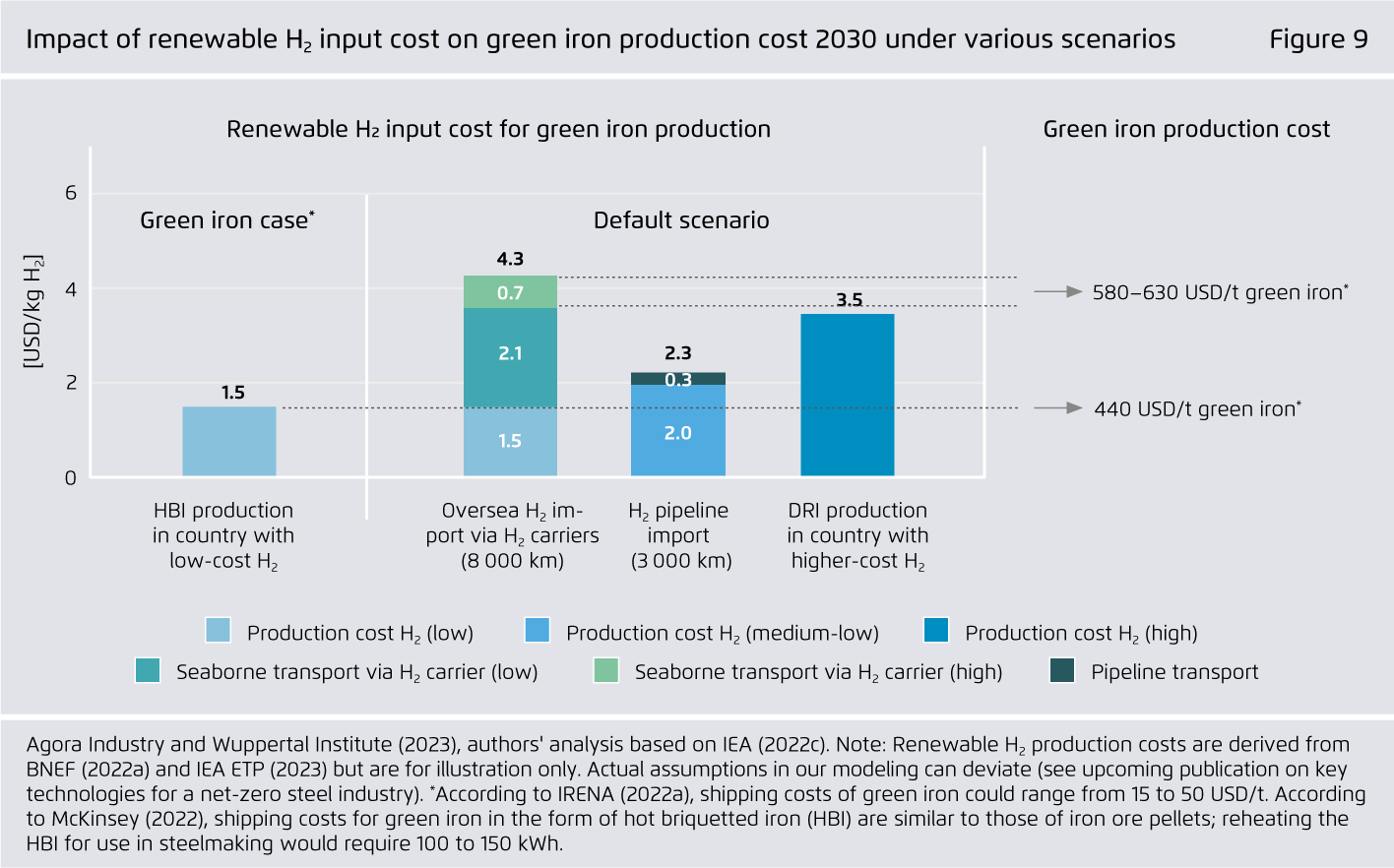
Under consideration of the Creative Commons license CC BY (attribution) the image may be further processed in any format or medium (also commercially, also in modified form), as long as the author is mentioned and a link to the license is given.
Comparison of two cross-country low-carbon steelmaking process chains
Figure 10 from 15 insights on the global steel transformation on page 23
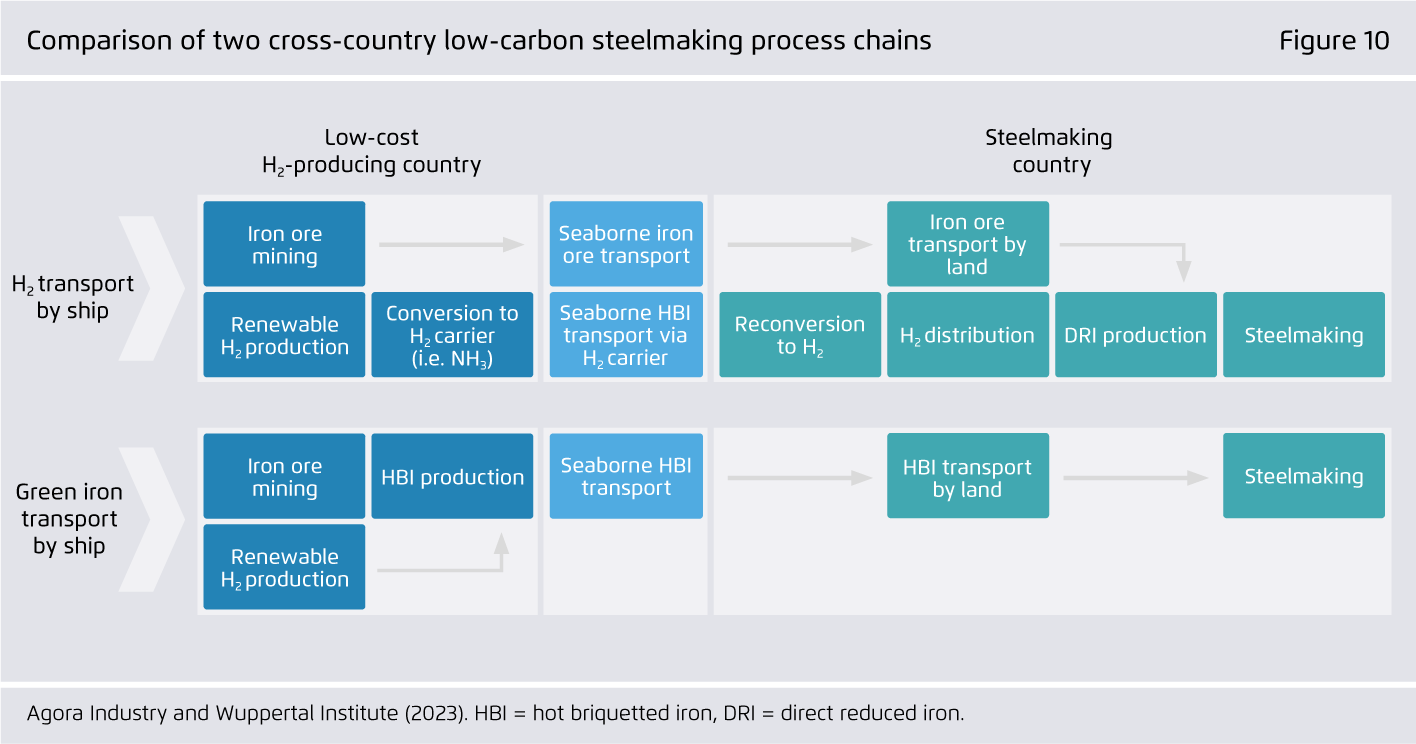
Under consideration of the Creative Commons license CC BY (attribution) the image may be further processed in any format or medium (also commercially, also in modified form), as long as the author is mentioned and a link to the license is given.
Green iron trade can be a win-win for importers and exporters
Figure 11 from 15 insights on the global steel transformation on page 24

Under consideration of the Creative Commons license CC BY (attribution) the image may be further processed in any format or medium (also commercially, also in modified form), as long as the author is mentioned and a link to the license is given.
Green iron importers and exporters: due to potential market power risks diversified strategies will be key
Figure 12 from 15 insights on the global steel transformation on page 25
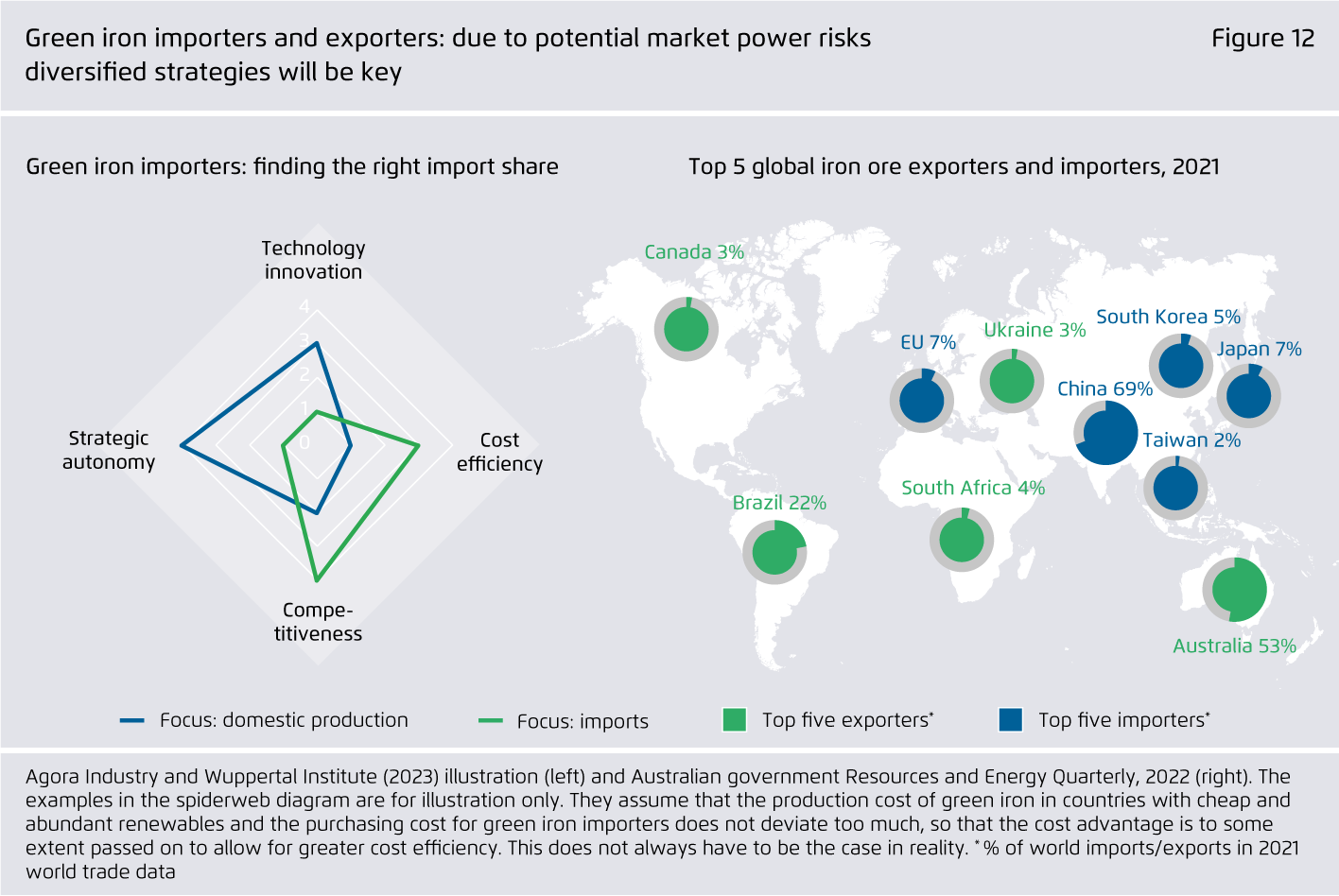
Under consideration of the Creative Commons license CC BY (attribution) the image may be further processed in any format or medium (also commercially, also in modified form), as long as the author is mentioned and a link to the license is given.
A massive scale-up of DRI is necessary to accelerate the global steel transformation
Figure 13 from 15 insights on the global steel transformation on page 27
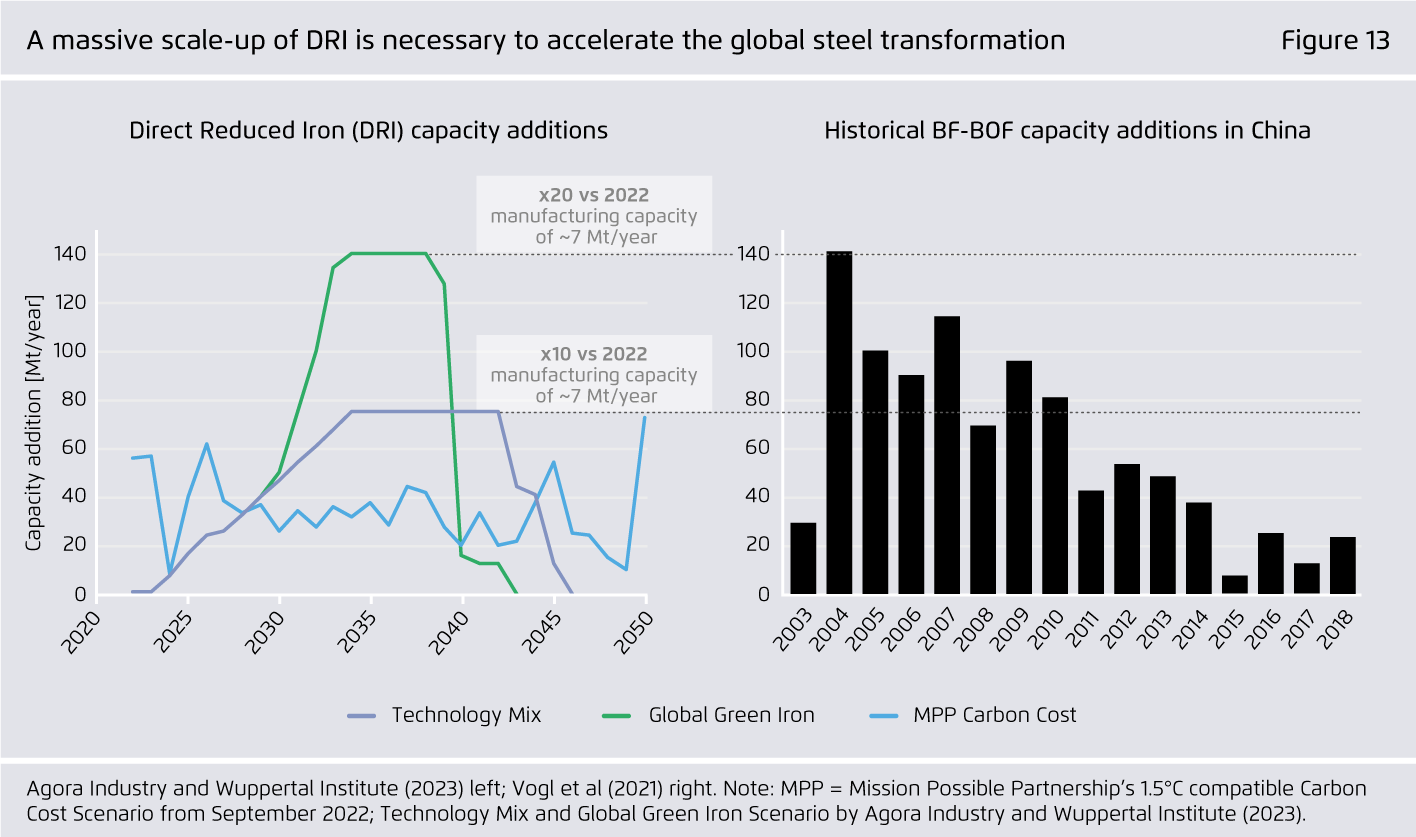
Under consideration of the Creative Commons license CC BY (attribution) the image may be further processed in any format or medium (also commercially, also in modified form), as long as the author is mentioned and a link to the license is given.
Direct reduced iron deployment in our scenarios compared to deployment of selected clean energy technologies in the IEA NZE Scenario
Figure 14 from 15 insights on the global steel transformation on page 28
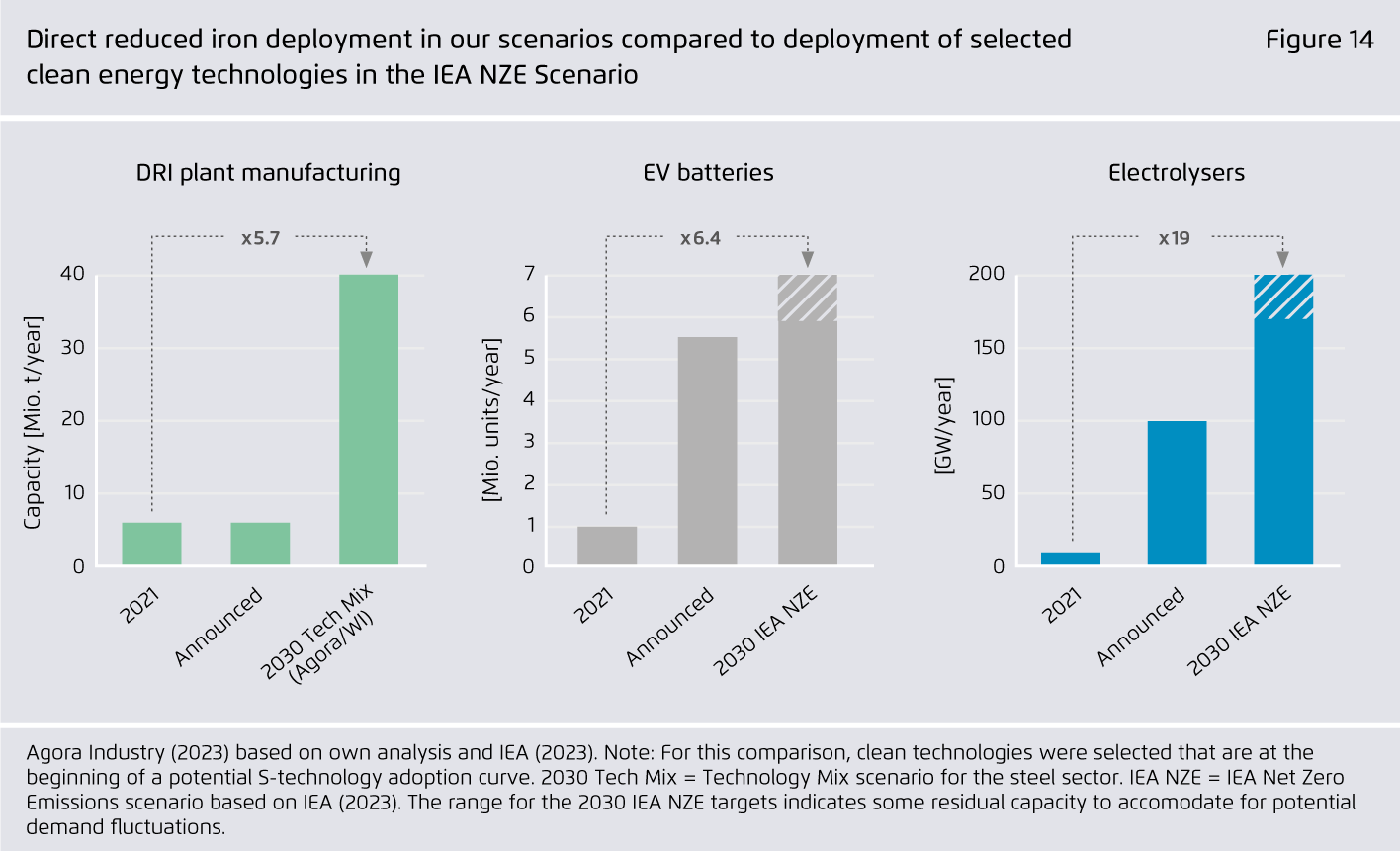
Under consideration of the Creative Commons license CC BY (attribution) the image may be further processed in any format or medium (also commercially, also in modified form), as long as the author is mentioned and a link to the license is given.
Negative emissions in di erent IPCC scenarios (left) and in our Technology Mix scenario (right)
Figure 15 from 15 insights on the global steel transformation on page 30

Under consideration of the Creative Commons license CC BY (attribution) the image may be further processed in any format or medium (also commercially, also in modified form), as long as the author is mentioned and a link to the license is given.
Carbon dioxide removal potential of various BECCS technologies in the steel sector for 6.4 EJ of sustainable primary biomass use
Figure 16 from 15 insights on the global steel transformation on page 31
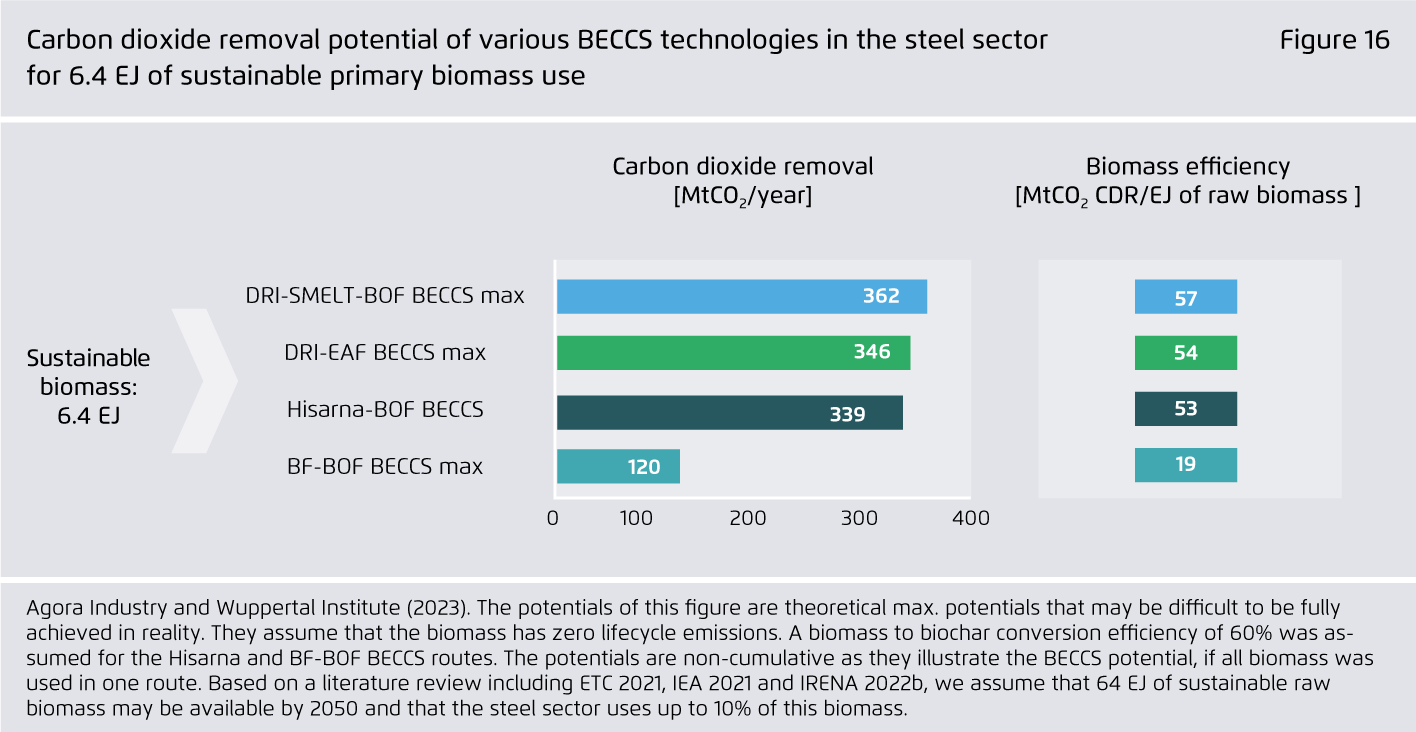
Under consideration of the Creative Commons license CC BY (attribution) the image may be further processed in any format or medium (also commercially, also in modified form), as long as the author is mentioned and a link to the license is given.
Where the global steel industry is heading: 2030 pipeline of low-carbon steelmaking announcements
Figure 17 from 15 insights on the global steel transformation on page 33
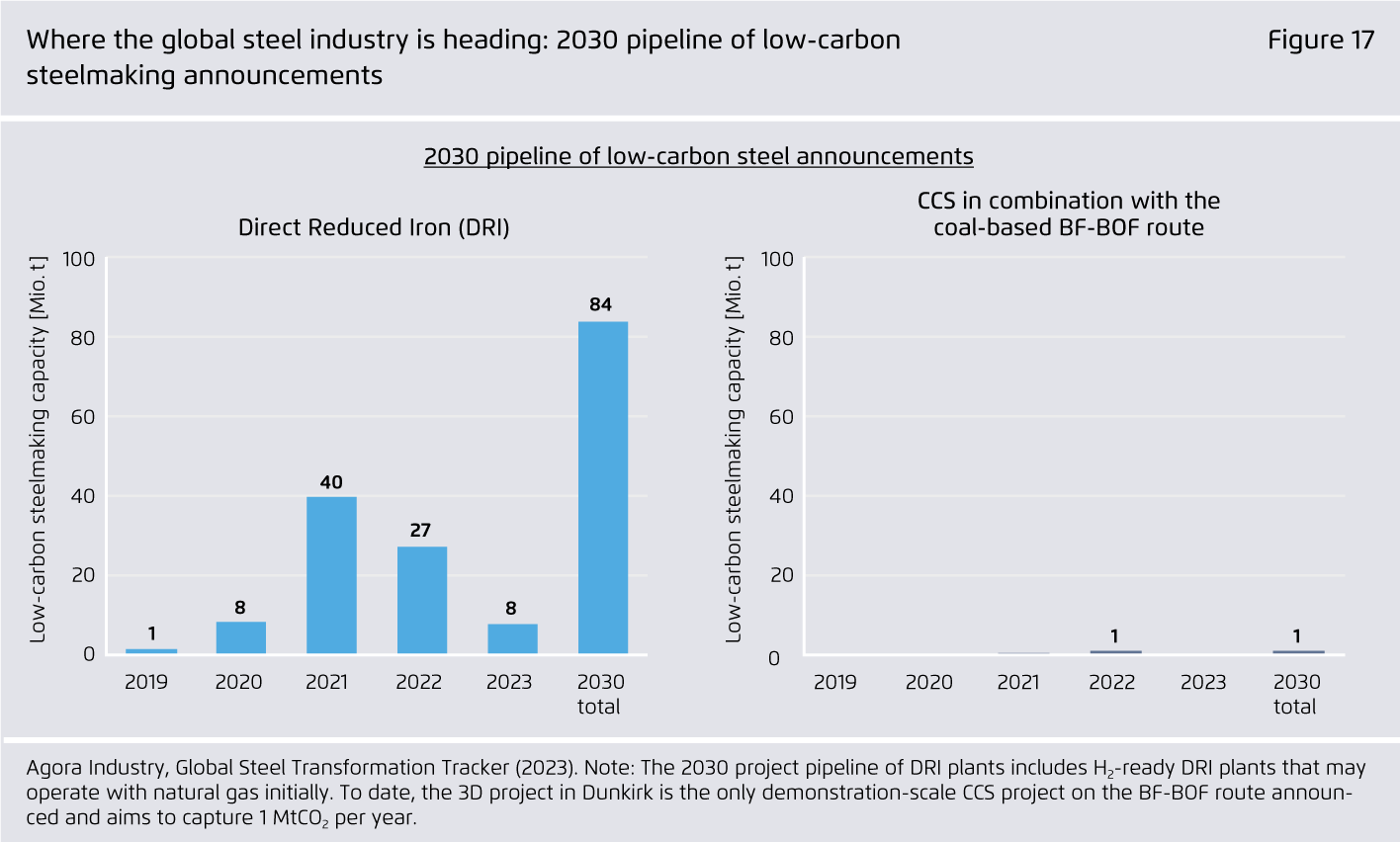
Under consideration of the Creative Commons license CC BY (attribution) the image may be further processed in any format or medium (also commercially, also in modified form), as long as the author is mentioned and a link to the license is given.
Several risk factors make CCS in combination with the BF-BOF route unattractive
Figure 18 from 15 insights on the global steel transformation on page 34
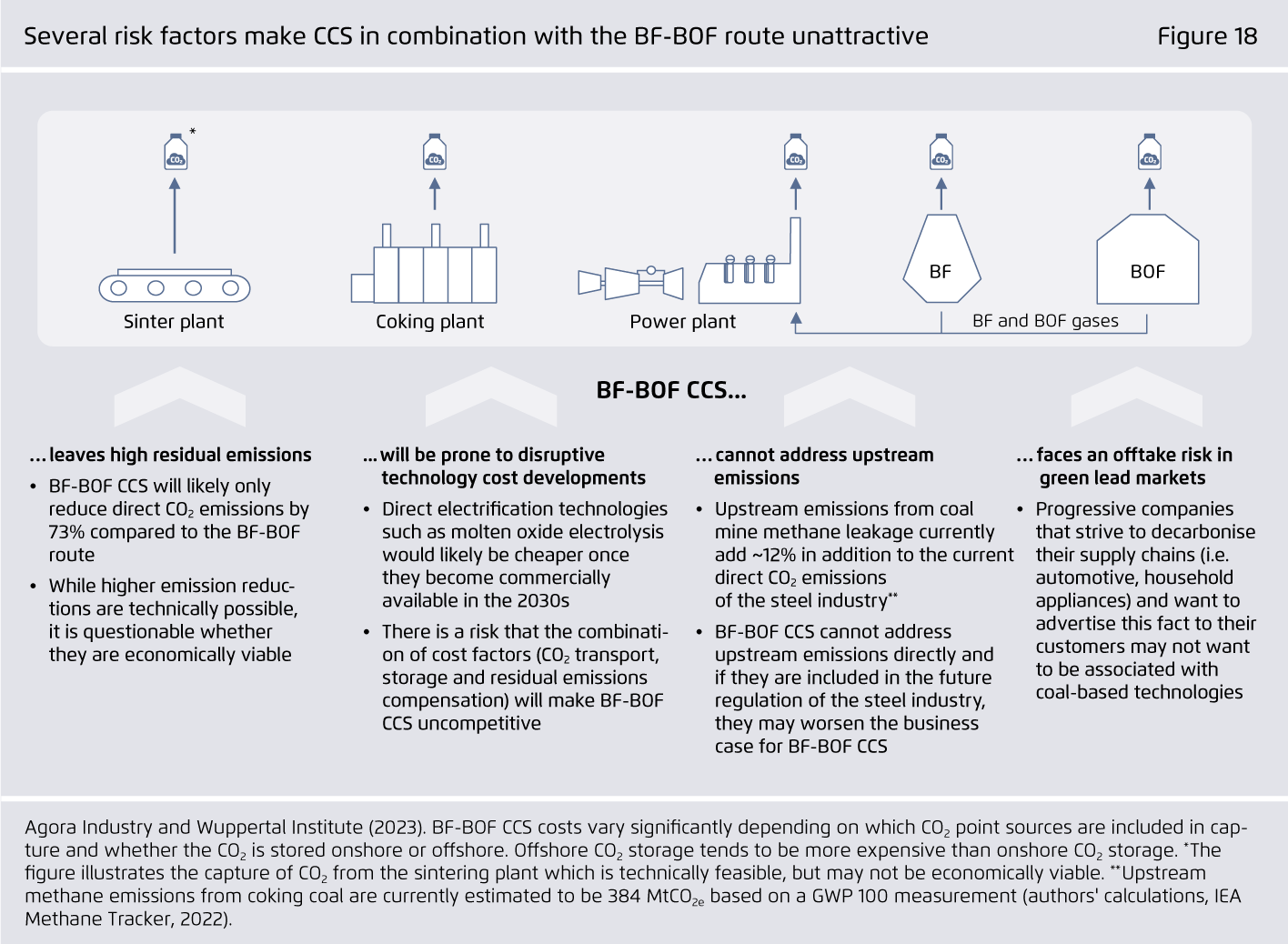
Under consideration of the Creative Commons license CC BY (attribution) the image may be further processed in any format or medium (also commercially, also in modified form), as long as the author is mentioned and a link to the license is given.
By 2040, over 90% of existing blast furnaces can be phased out without a premature shutdown
Figure 19 from 15 insights on the global steel transformation on page 36
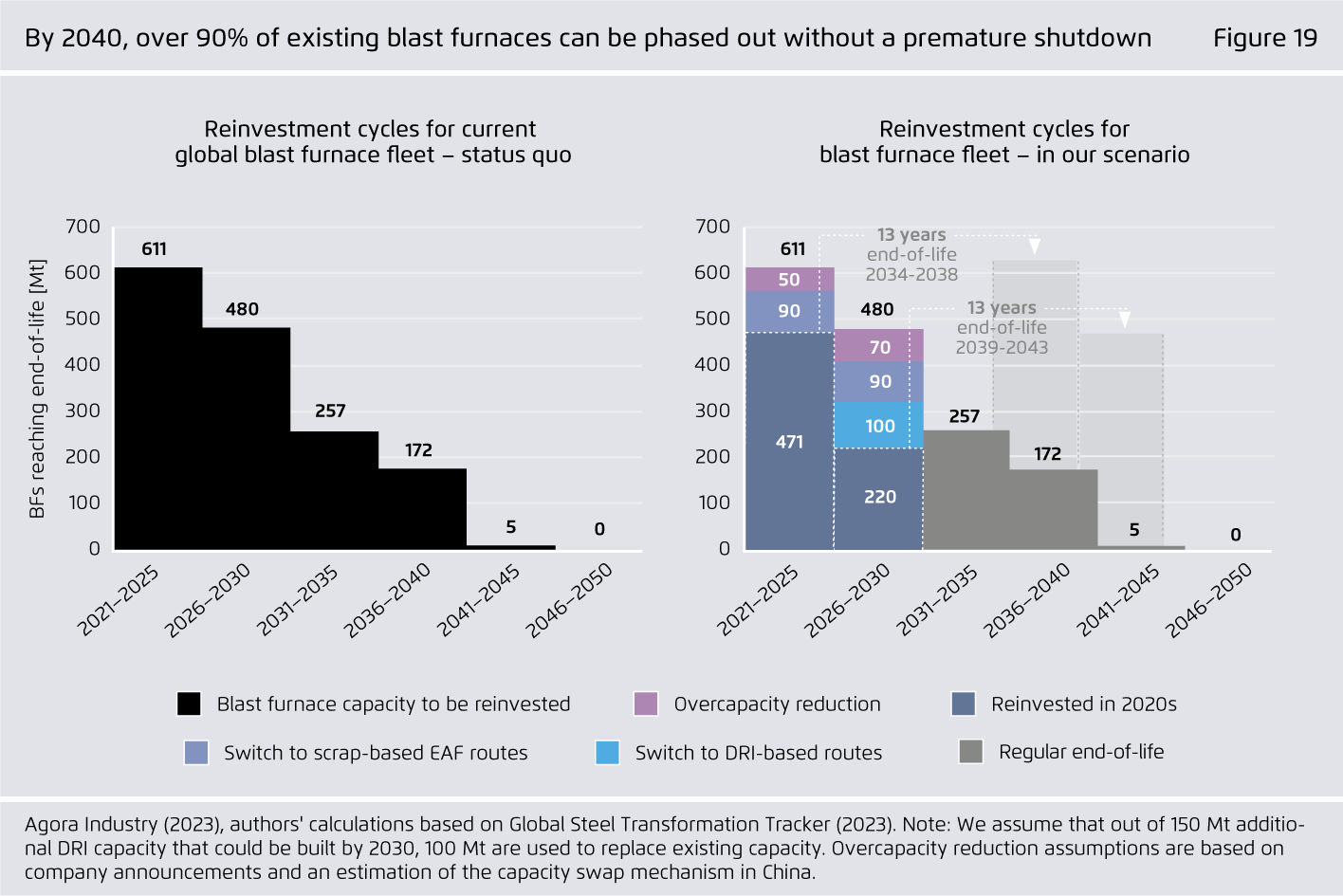
Under consideration of the Creative Commons license CC BY (attribution) the image may be further processed in any format or medium (also commercially, also in modified form), as long as the author is mentioned and a link to the license is given.
Lifetime of blast furnace campaigns and various blast furnace retrofit measures
Figure 20 from 15 insights on the global steel transformation on page 37
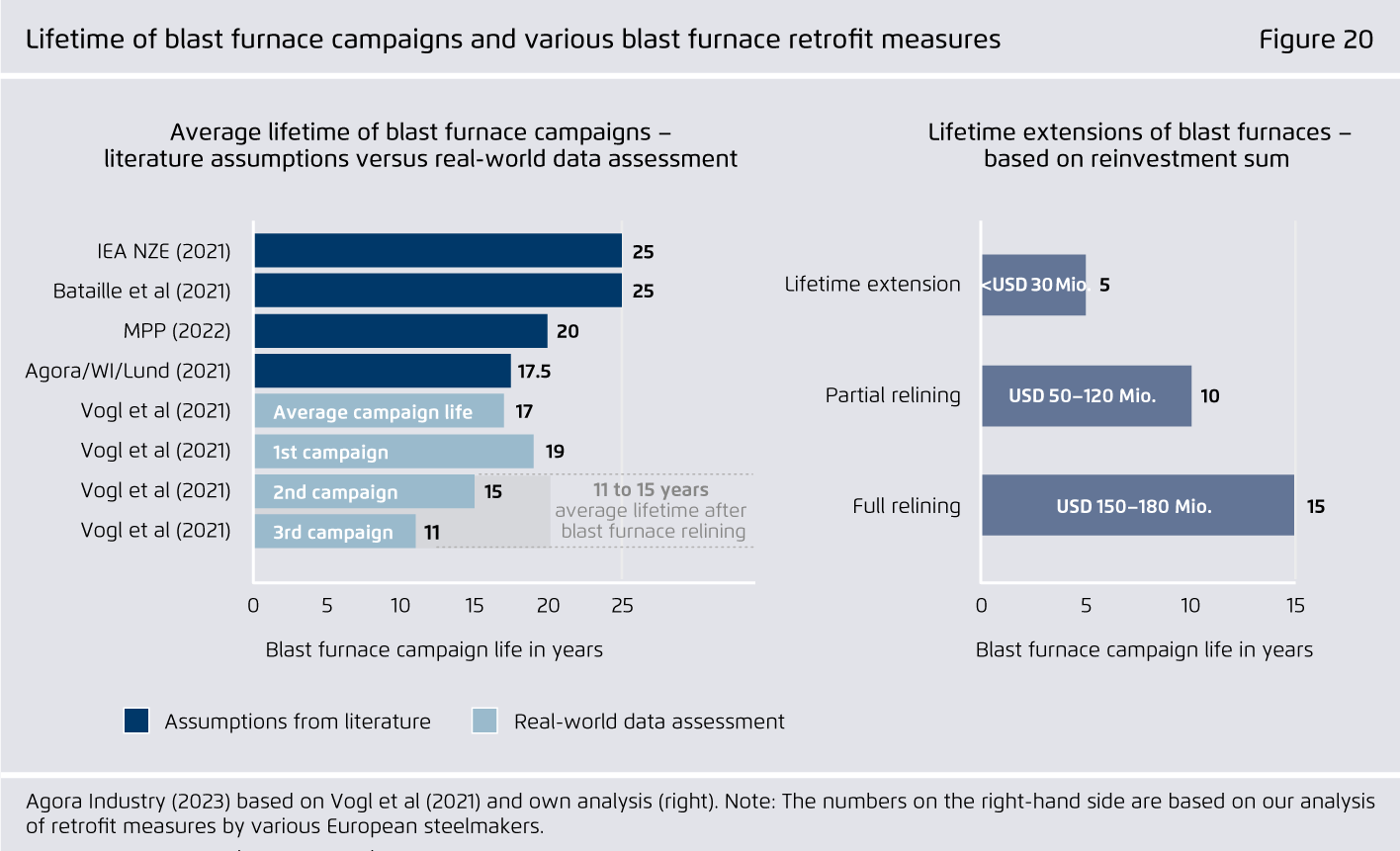
Under consideration of the Creative Commons license CC BY (attribution) the image may be further processed in any format or medium (also commercially, also in modified form), as long as the author is mentioned and a link to the license is given.
The current project pipeline for new coal-based BF-BOF plants is facing a large carbon lock-in and stranded asset risk
Figure 21 from 15 insights on the global steel transformation on page 39

Under consideration of the Creative Commons license CC BY (attribution) the image may be further processed in any format or medium (also commercially, also in modified form), as long as the author is mentioned and a link to the license is given.
Shifting investments in emerging economies from coal to clean will require a solution for the higher OPEX costs
Figure 22 from 15 insights on the global steel transformation on page 41

Under consideration of the Creative Commons license CC BY (attribution) the image may be further processed in any format or medium (also commercially, also in modified form), as long as the author is mentioned and a link to the license is given.
2030 low-carbon H₂ supply pipeline versus low-carbon H₂ demand from steel sector by 2030 in our scenarios
Figure 23 from 15 insights on the global steel transformation on page 42
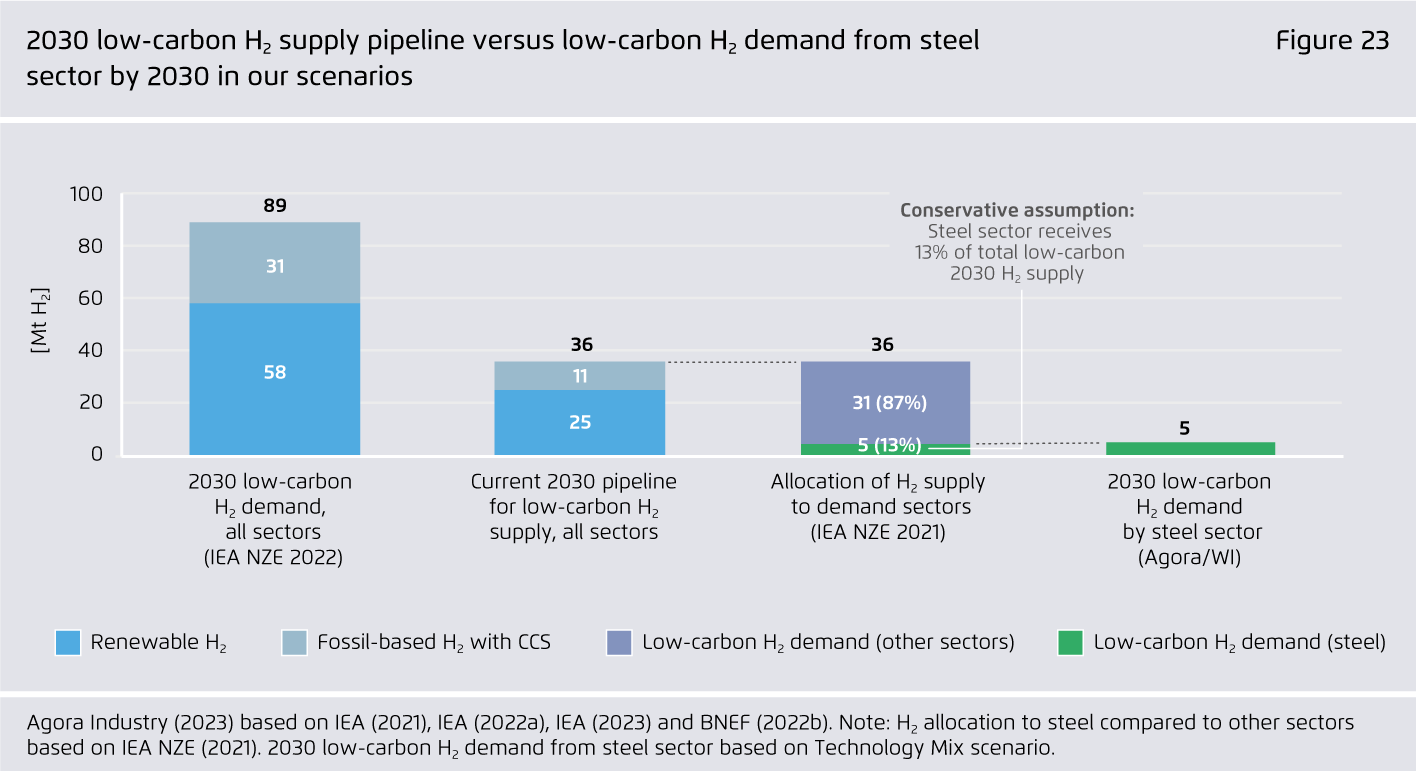
Under consideration of the Creative Commons license CC BY (attribution) the image may be further processed in any format or medium (also commercially, also in modified form), as long as the author is mentioned and a link to the license is given.
No-regret H₂ use: steel has the highest CO₂ mitigation potential compared to various other H₂ applications
Figure 24 from 15 insights on the global steel transformation on page 44
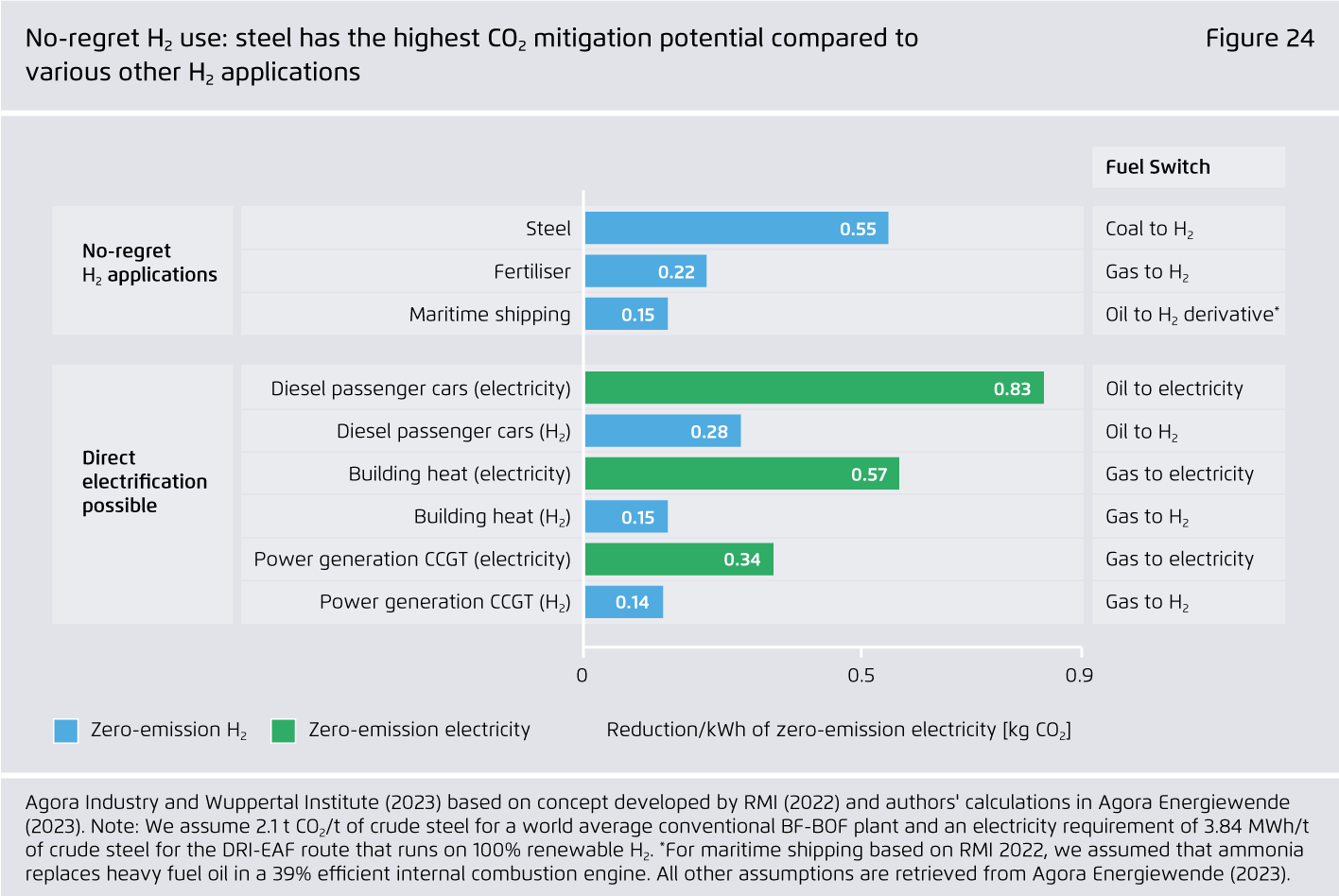
Under consideration of the Creative Commons license CC BY (attribution) the image may be further processed in any format or medium (also commercially, also in modified form), as long as the author is mentioned and a link to the license is given.
How the bottleneck of DR-grade pellets can be addressed
Figure 25 from 15 insights on the global steel transformation on page 45
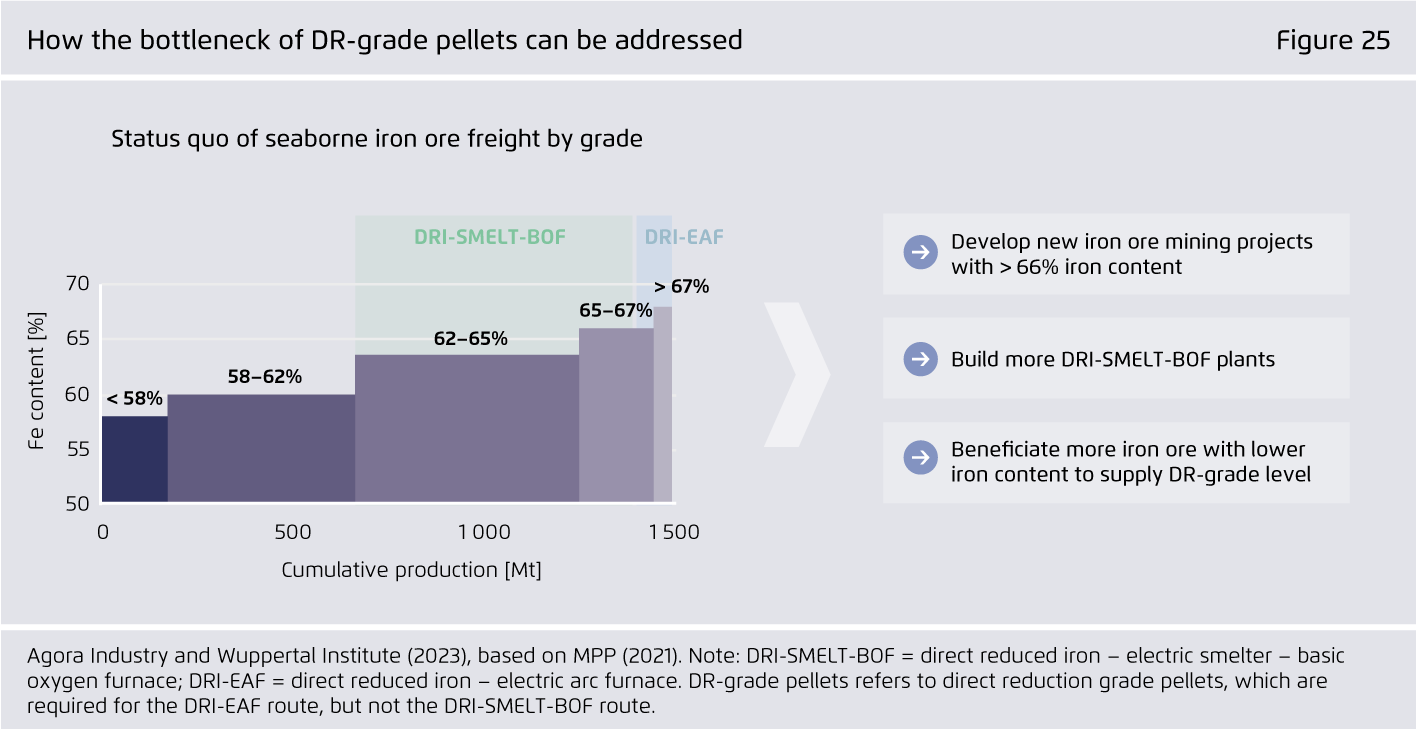
Under consideration of the Creative Commons license CC BY (attribution) the image may be further processed in any format or medium (also commercially, also in modified form), as long as the author is mentioned and a link to the license is given.
Unless urgent action is taken 2030 DR-grade iron ore demand will significantly outstrip DR-grade iron ore supply
Figure 26 from 15 insights on the global steel transformation on page 46
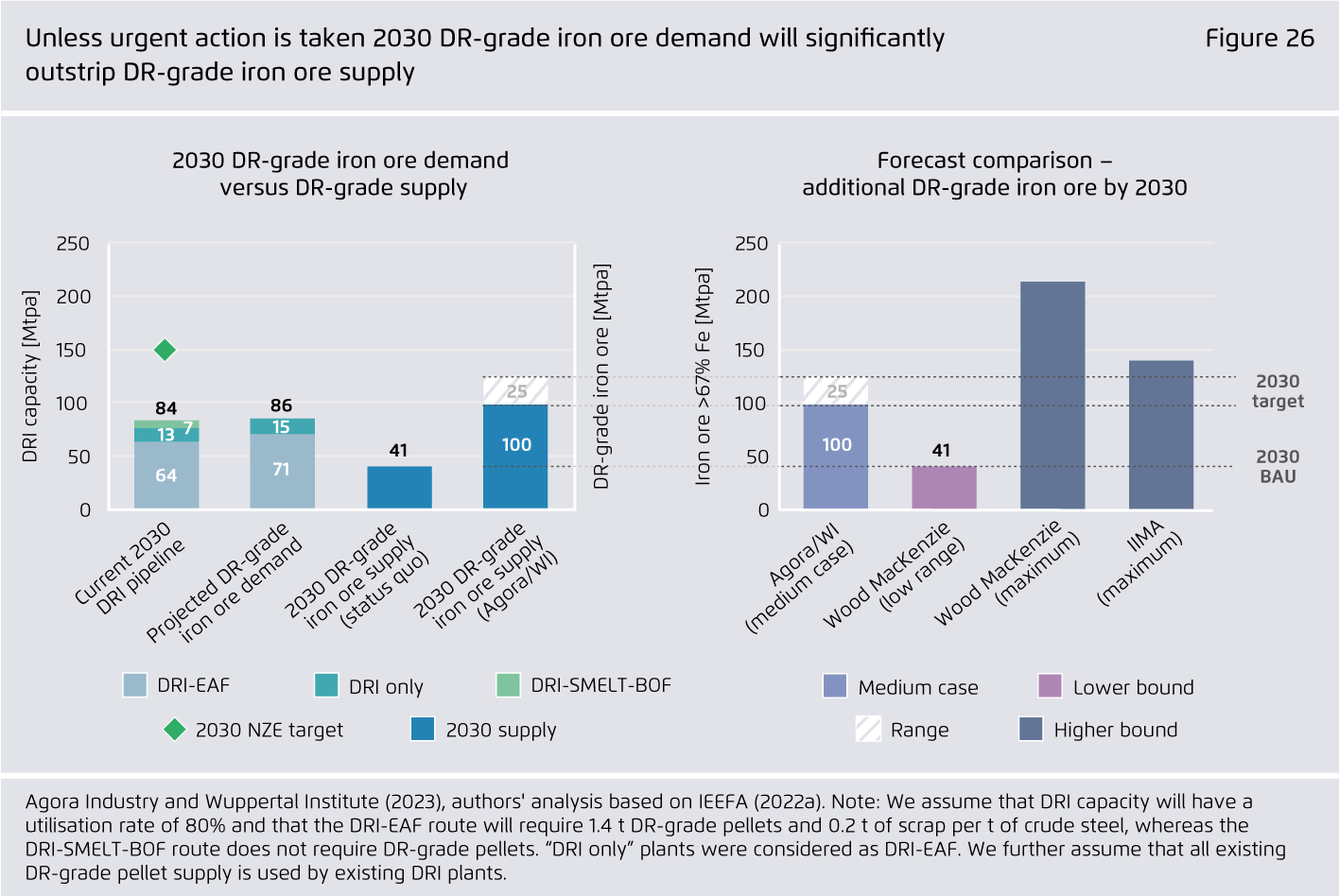
Under consideration of the Creative Commons license CC BY (attribution) the image may be further processed in any format or medium (also commercially, also in modified form), as long as the author is mentioned and a link to the license is given.
Key bottlenecks up to 2030: The state of play
Figure 27 from 15 insights on the global steel transformation on page 48

Under consideration of the Creative Commons license CC BY (attribution) the image may be further processed in any format or medium (also commercially, also in modified form), as long as the author is mentioned and a link to the license is given.
2030 pipeline: near-zero emissions primary steelmaking capacity announcements and final investment decisions
Figure 28 from 15 insights on the global steel transformation on page 50
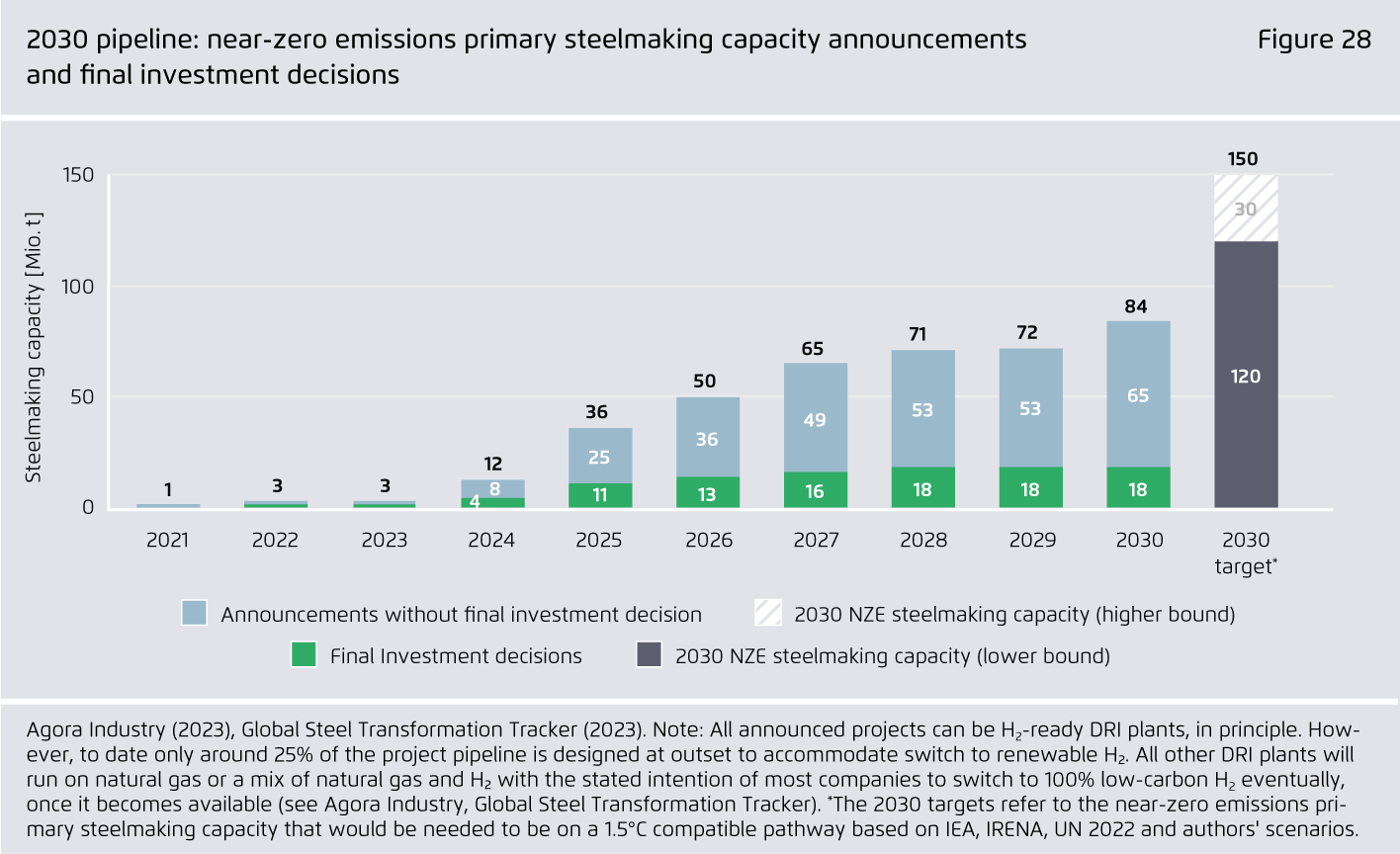
Under consideration of the Creative Commons license CC BY (attribution) the image may be further processed in any format or medium (also commercially, also in modified form), as long as the author is mentioned and a link to the license is given.
A net-zero steel sector requires a comprehensive policy framework across the entire value chain
Figure 29 from 15 insights on the global steel transformation on page 51
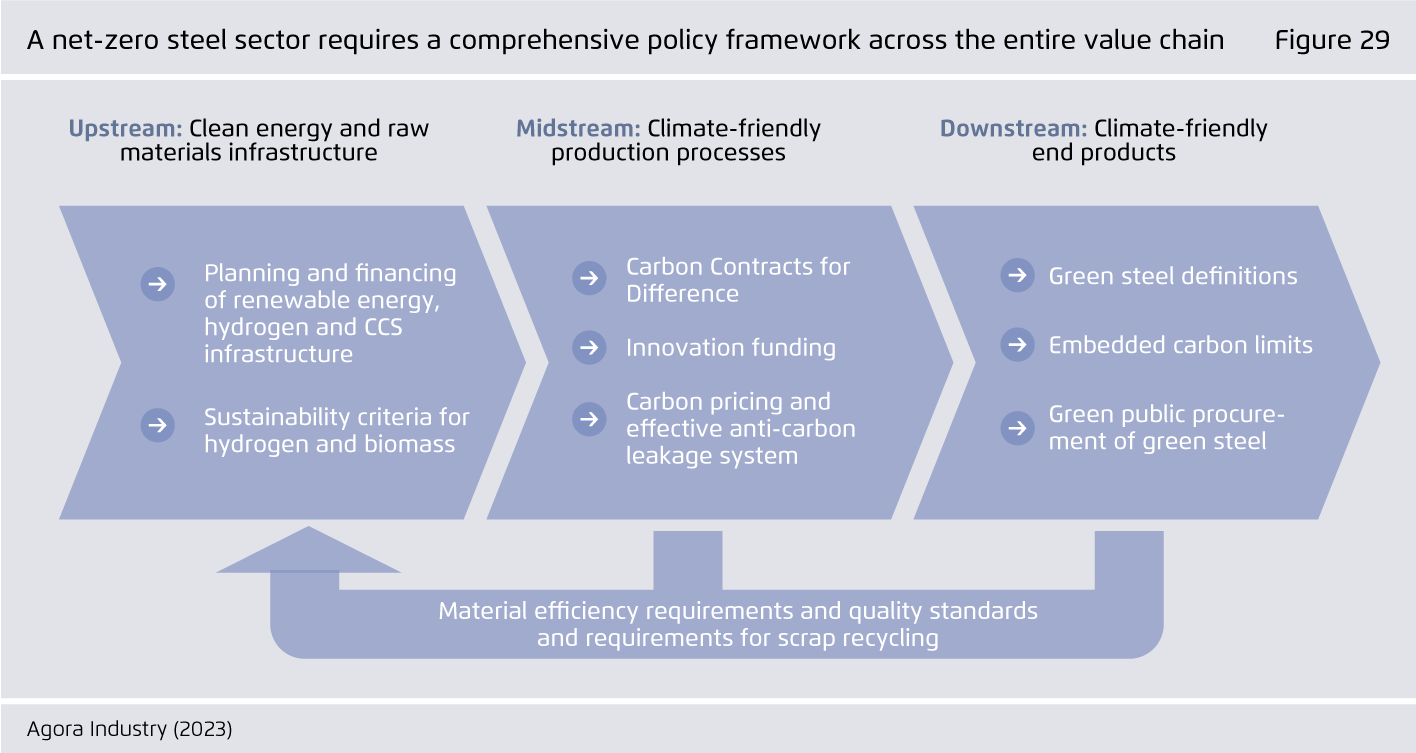
Under consideration of the Creative Commons license CC BY (attribution) the image may be further processed in any format or medium (also commercially, also in modified form), as long as the author is mentioned and a link to the license is given.
2030 CO₂ abatement cost of key technologies versus the unabated blast furnace – basic oxygen furnace route
Figure 30 from 15 insights on the global steel transformation on page 52
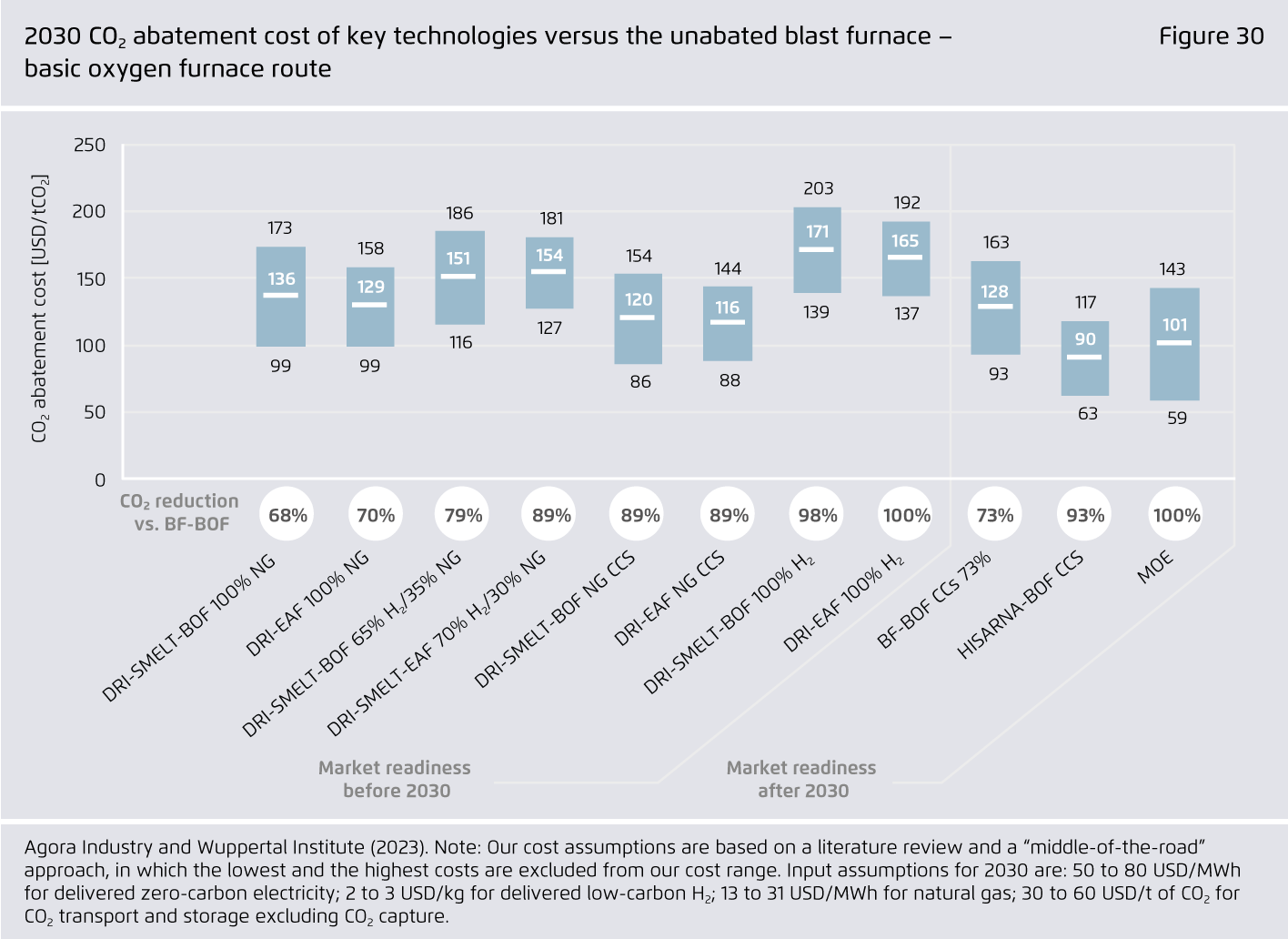
Under consideration of the Creative Commons license CC BY (attribution) the image may be further processed in any format or medium (also commercially, also in modified form), as long as the author is mentioned and a link to the license is given.





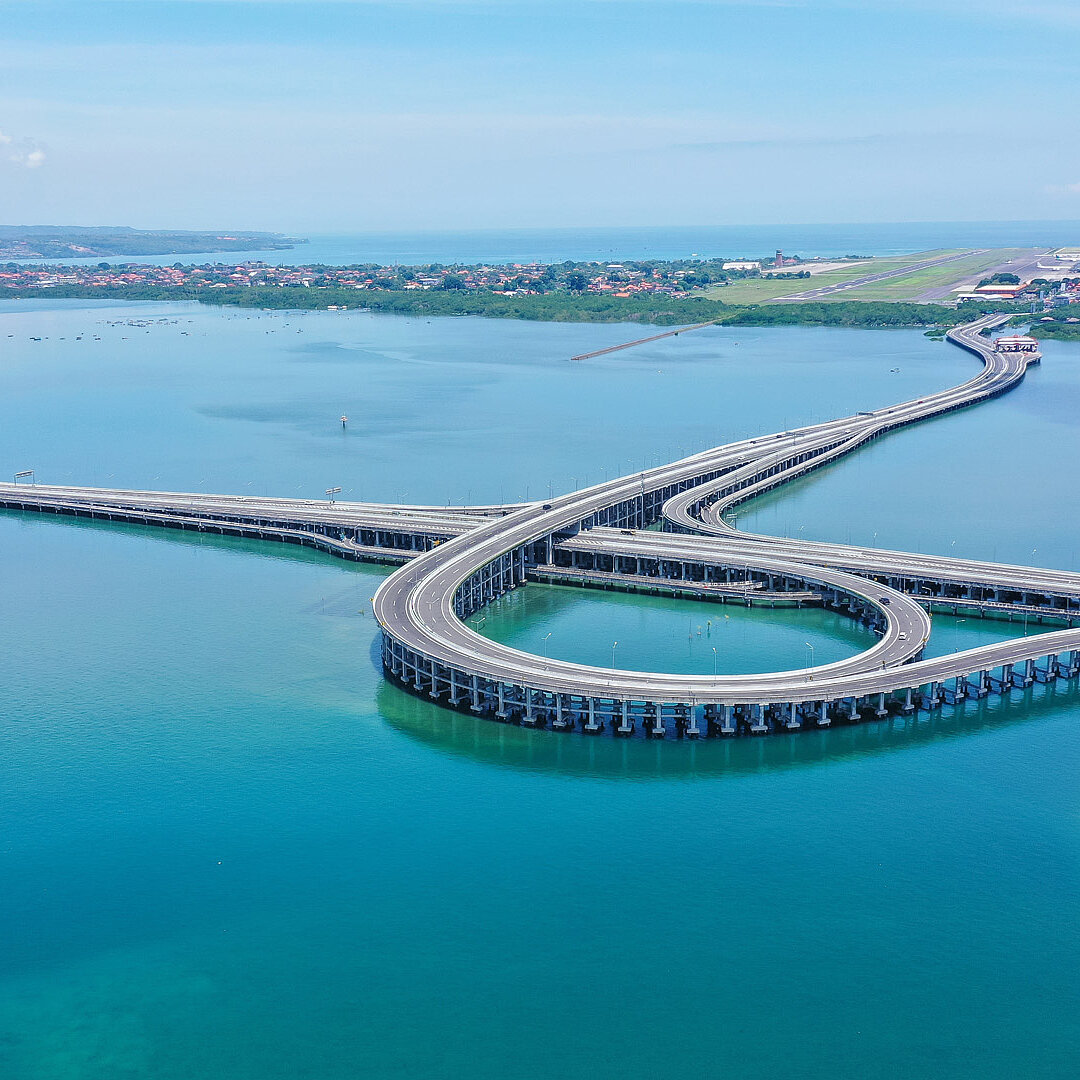

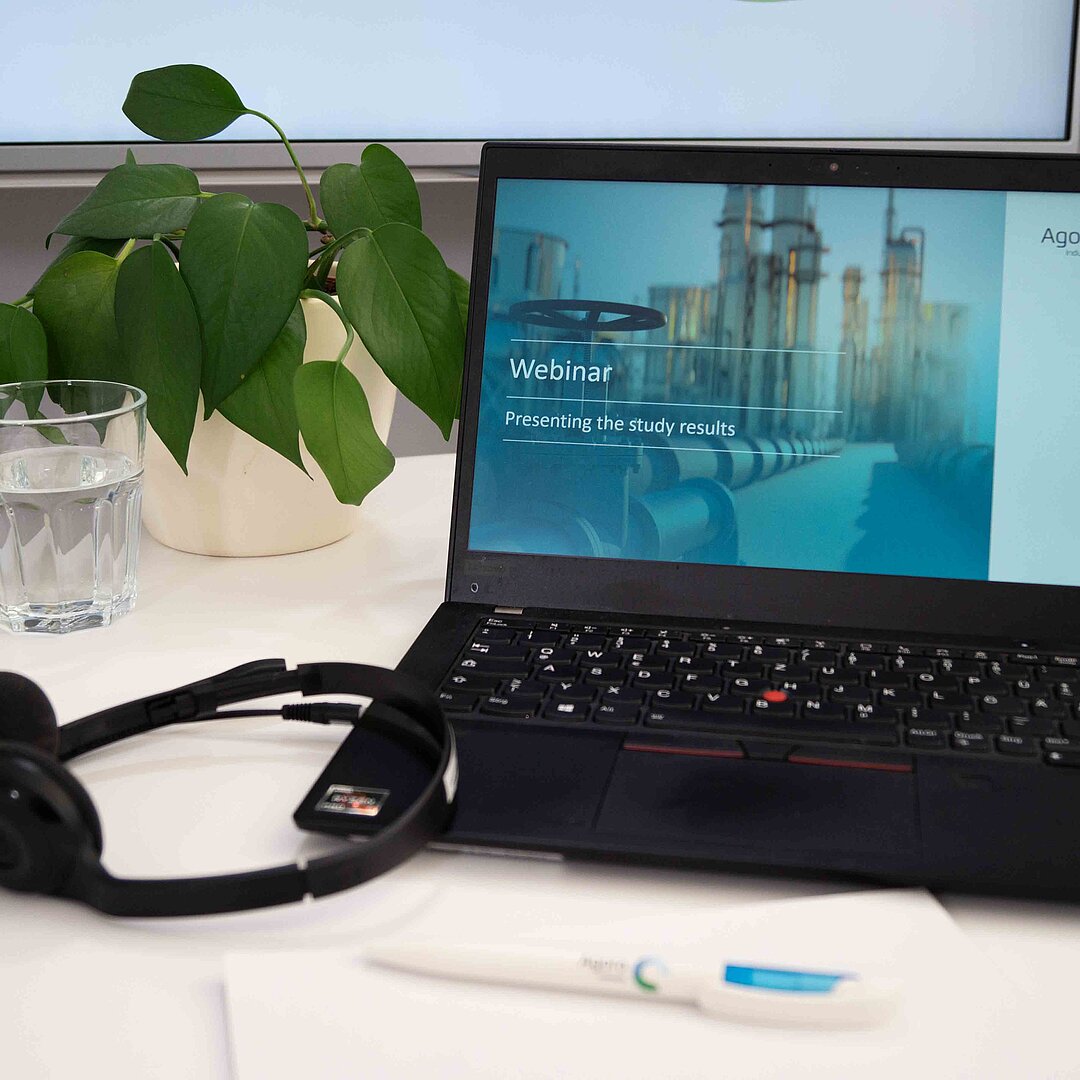
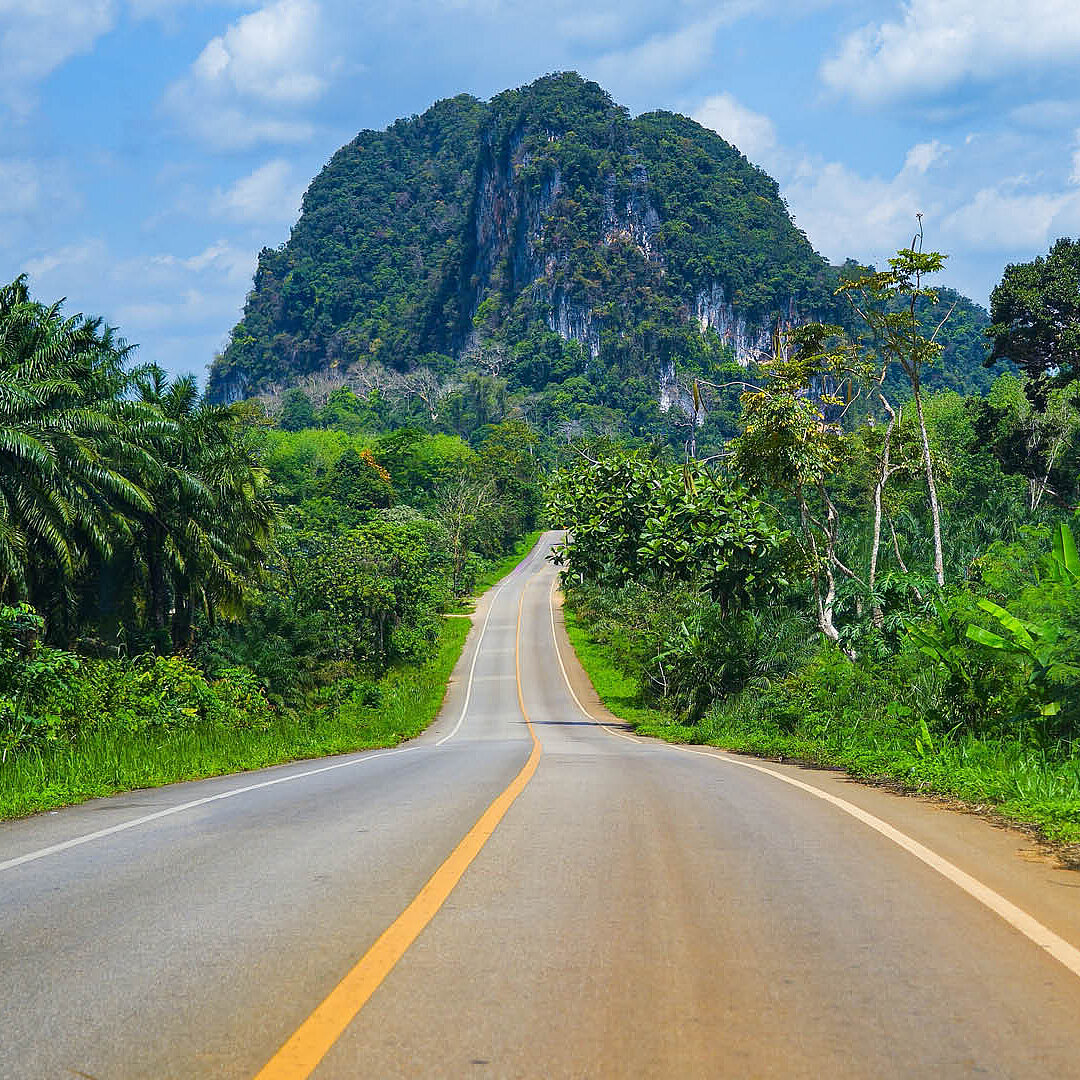
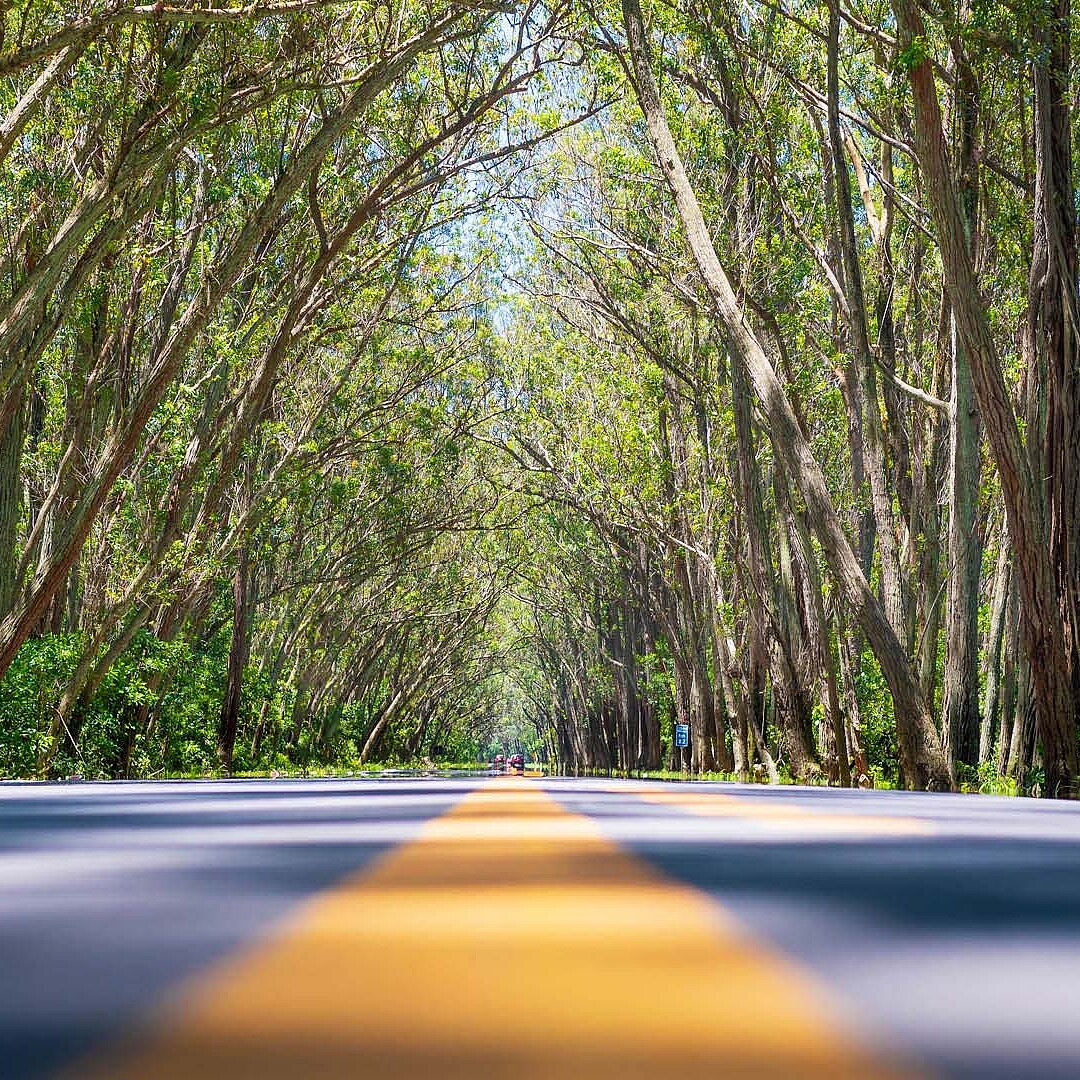





![The global steel industry can achieve net-zero emissions by the early 2040s [Translate to English:]](/fileadmin/_processed_/8/f/csm_15_insights_global_steel_news_73f640a802.jpg)
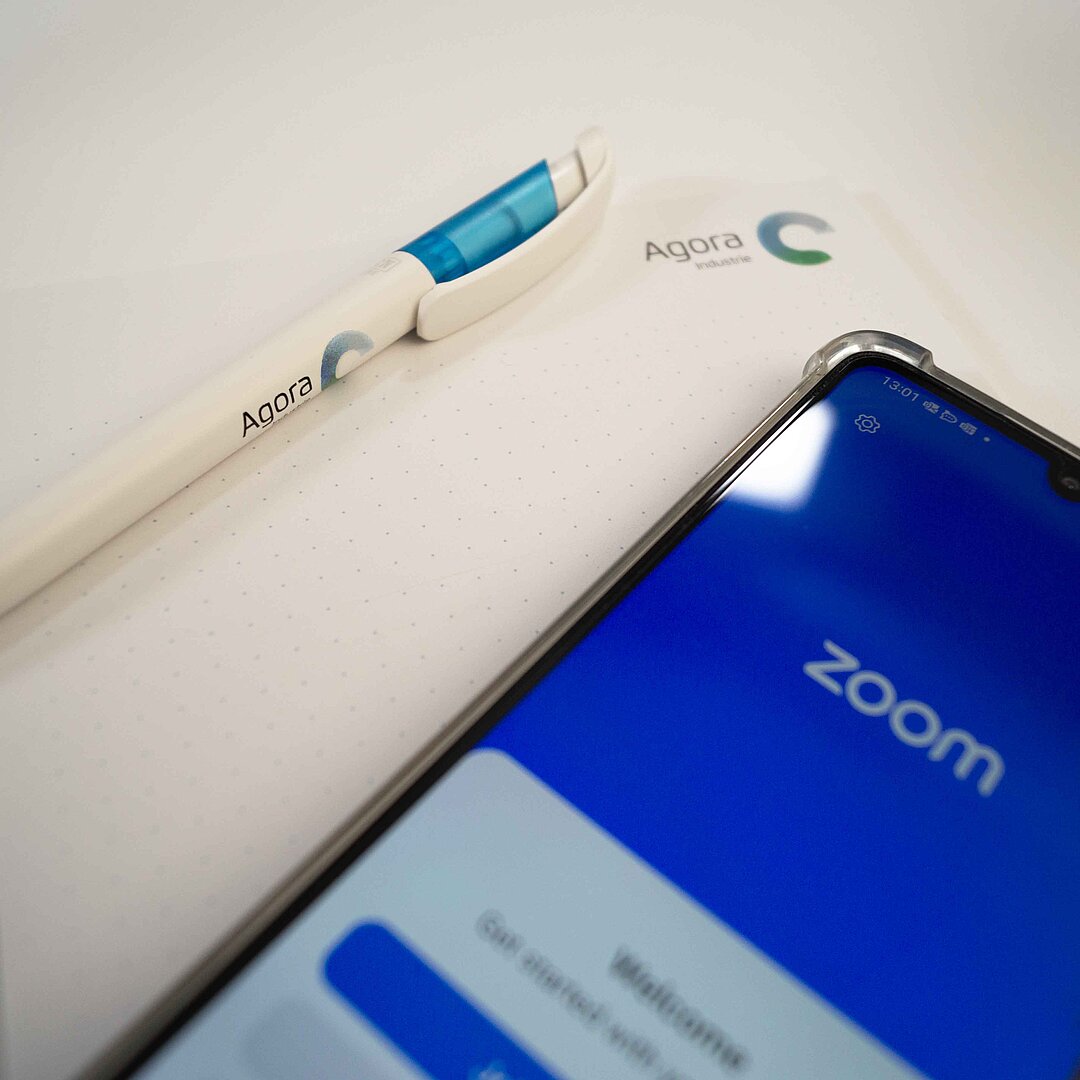
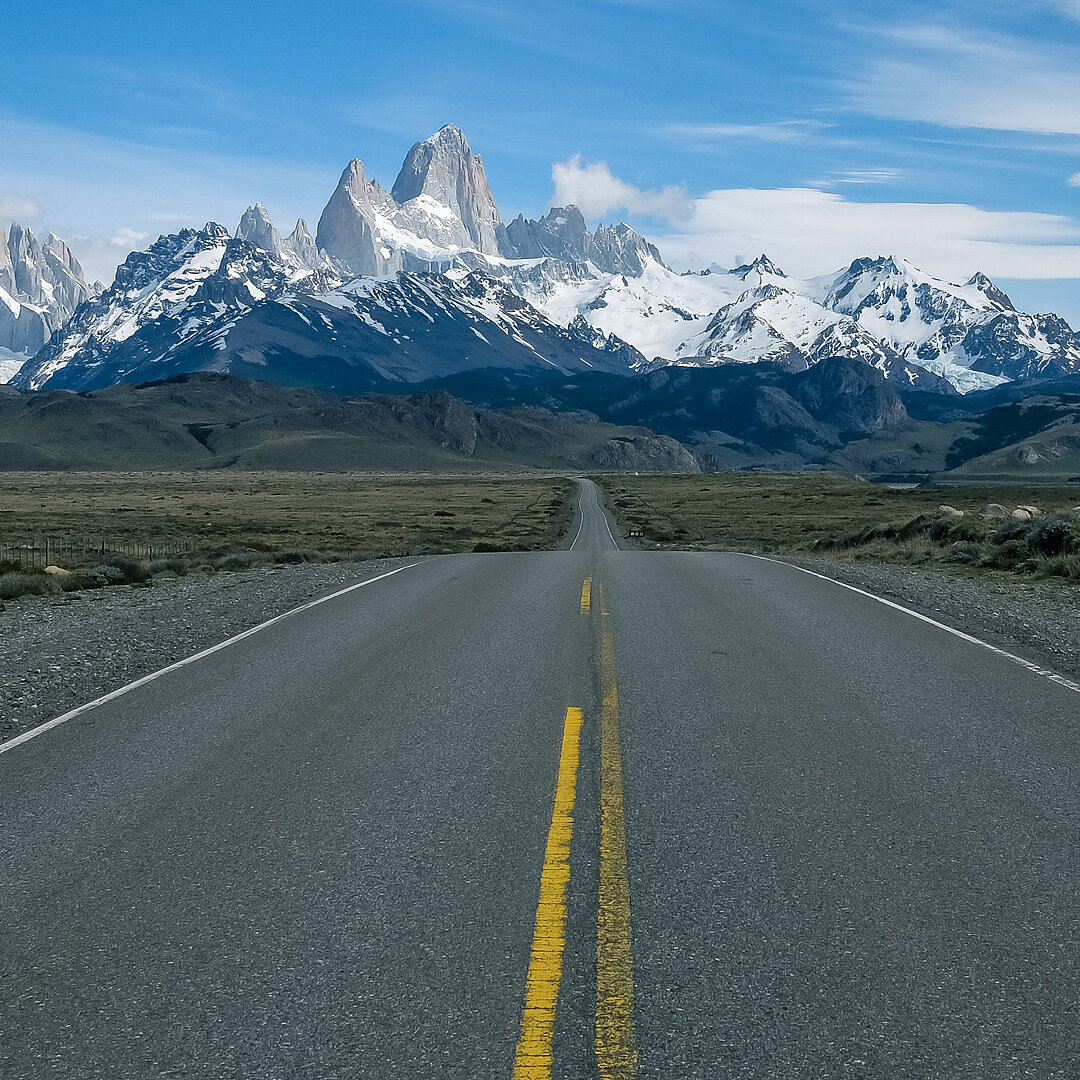
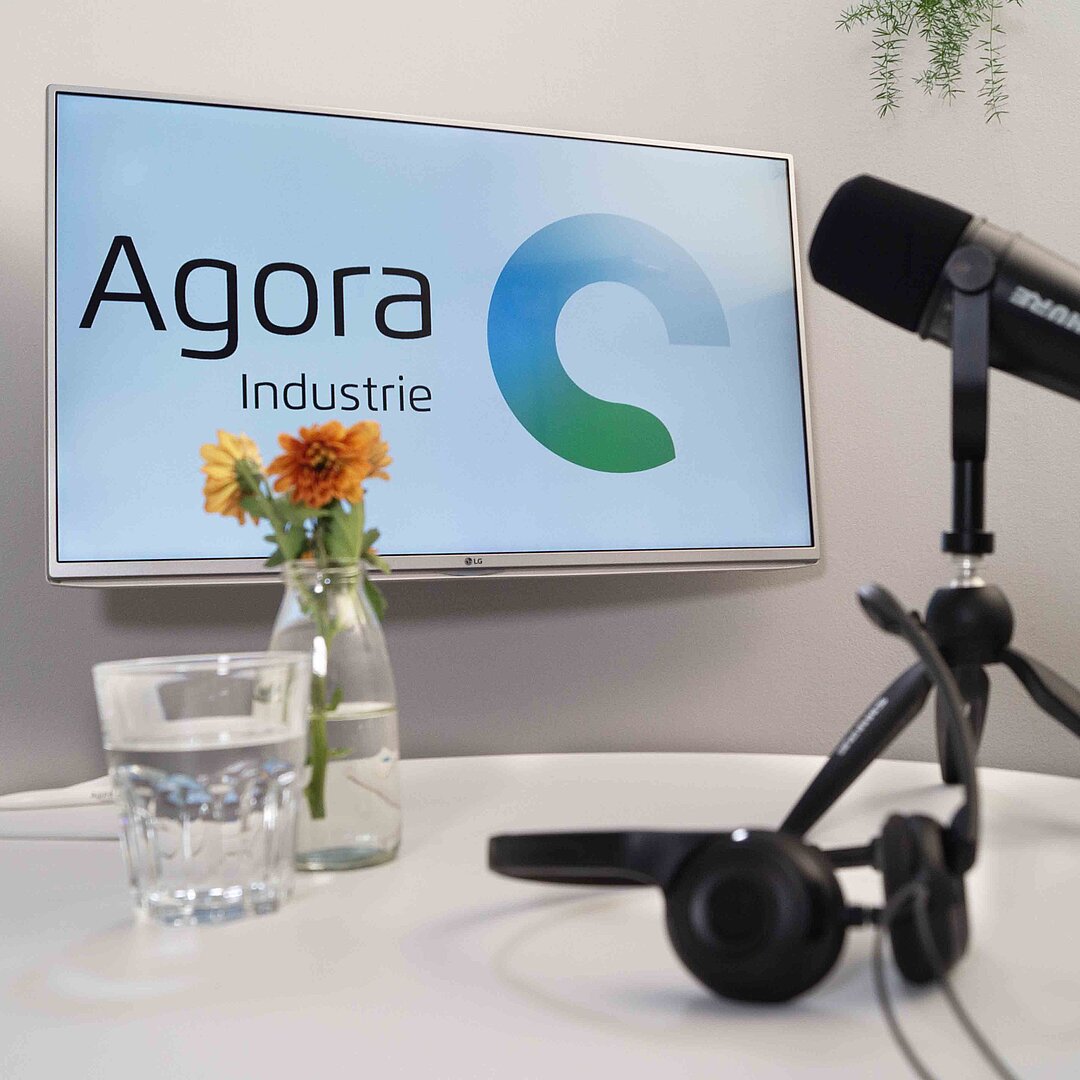
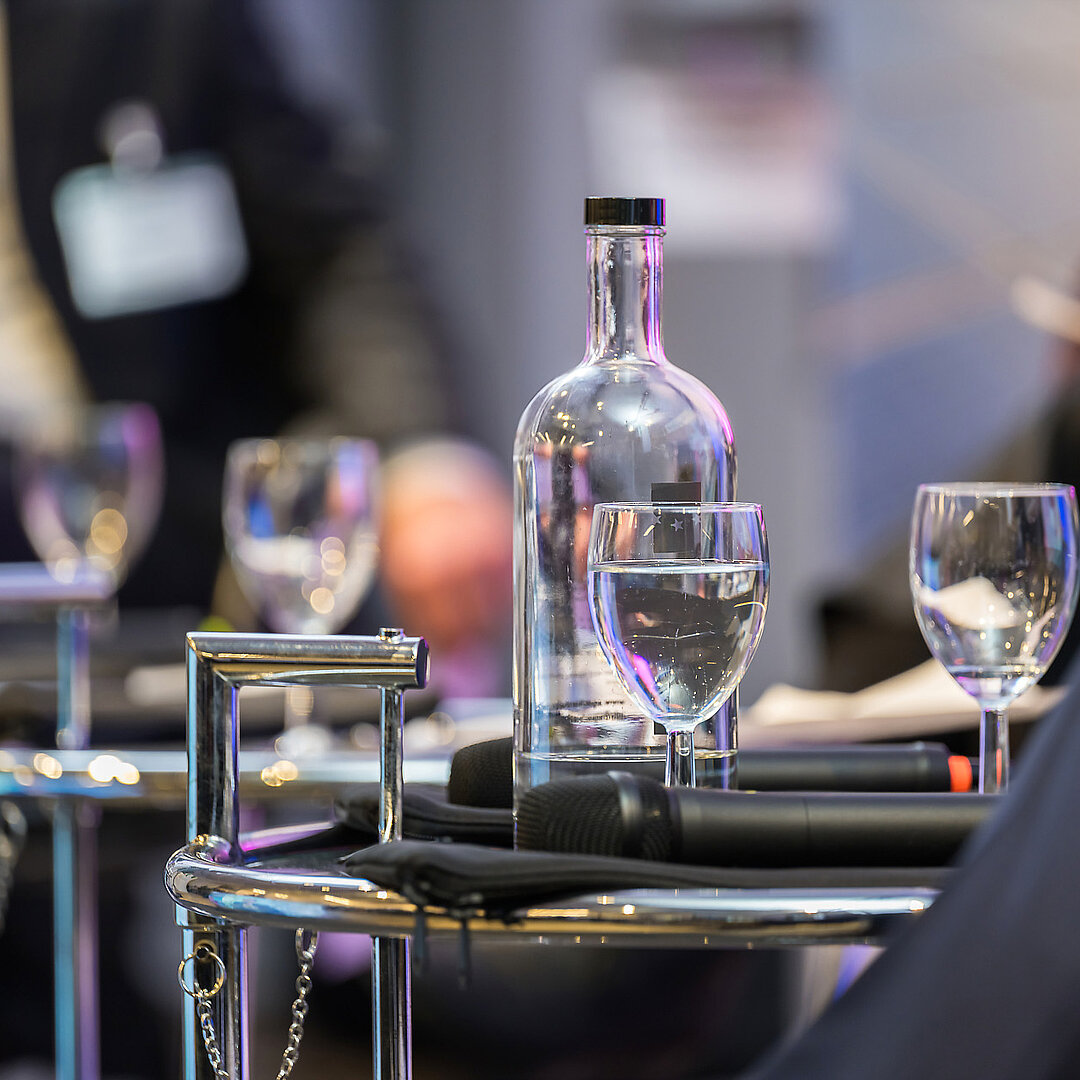
![Shifting global steel reinvestments from coal to clean [Translate to English:]](/fileadmin/_processed_/9/e/csm_global-steel_project_news_2_283e600f74.jpg)
